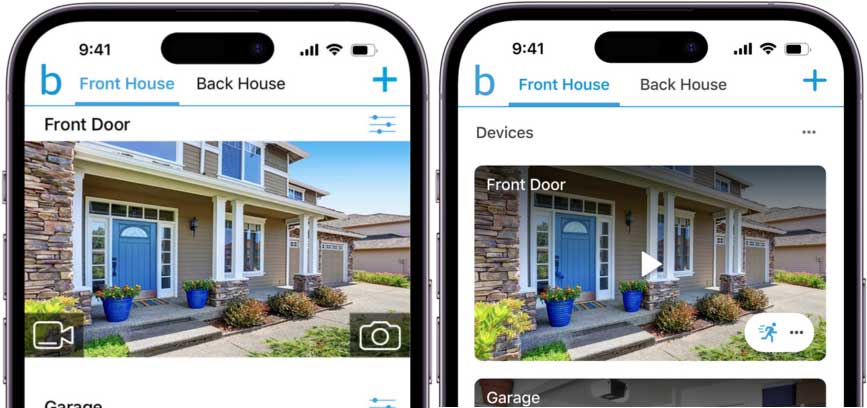Using and troubleshooting the Blink app, Use the Blink Home Monitor app to check in on what’s happening at home from anywhere at any time. The app connects your home to your phone in HD video so you can see and protect what matters most. With multi-system support, you can use Blink to watch your home, vacation home, or business all at the same time. Plus, you can control multiple camera systems within one single app!
Download the app today:
Using and troubleshooting the Blink app
Can I have multiple Blink Systems on one Account?
Blink cameras work together with a Sync Module to create a system. You can have multiple systems within an account. The Blink app allows you to manage multiple Sync Module systems and their connected Blink devices from a single account.
Each Sync Module added to your account allows you to group and manage up to ten cameras in a single system.
Learn more about adding your Sync Module 2 to a new or existing system.
Self-Managed Blink Cameras
Alternatively, some Blink devices can create and manage their own systems. These are:
While these devices can create their own system, they are capable of joining existing Sync Module-managed systems as well.
Reasons to have multiple systems
An account with multiple systems can be useful for situations such as:
Accessing your other systems
After multiple systems are added to an account, you can select them by tapping on their name at the top of the Home screen. Swipe your finger across the top to scroll and view more systems.
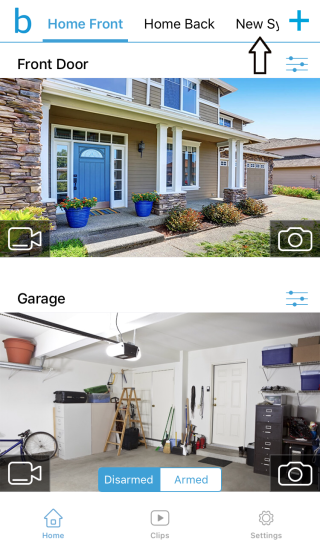
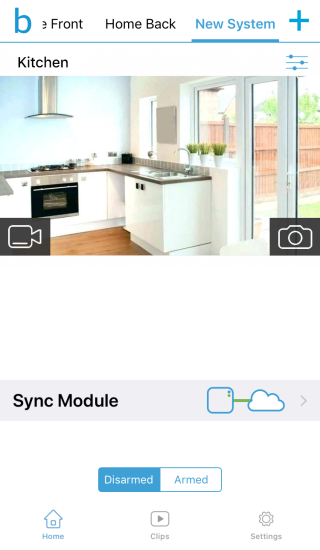
Security Best Practices
For your system security, Blink cameras always use encrypted connections. Blink also hides account details from our support agents until you grant access permission in the Blink app.
Here are some best practices to keep your Blink account secure:
Share account information only with those you trust
Blink will never ask for login credentials or account password. As the account owner, sharing account access should only be with trusted people. Learn more about managing multiple devices on your Blink account.
Note: Any person signed in to your Blink account has access to view and manage all of your Blink devices and account information.
Using and troubleshooting the Blink app
Read More : How to Set Up UBOX Camera
Create strong passwords
We recommend that you don’t use the same password for multiple accounts and services. Blink passwords can be any combination of letters, numbers, and symbols (ASCII standard characters) and must meet the following requirements:
Regularly update your passwords
It is a good practice to update your passwords every three to six months. If you suspect your account has been compromised, we recommend immediately changing your password.
Create a new account in the Blink app
New to Blink? Get started here
This article will help you get started with the Blink app and setting up your new Blink account.
The latest version of the Blink app is always available in your app store. Blink supports most smartphones, tablets, and many Alexa-enabled products.
Tap your preferred app store option below to download the latest version of the Blink app.
Version: 6.31.0
for iOS 14 and later
Version: 6.31.0
for Android v6.0 and later
Version: 6.31.0
for Fire OS v7.0 and later
How to Update your iOS and Android devices
In order to run the latest version of the Blink app, it’s important your mobile device meets the minimum system requirements.
How to auto update your mobile devices
The easiest way to keep the app version of your mobile device current is to turn on the Automatic Update option in your device settings:
How to manually update your mobile devices
Note
We recommend that you always backup your data prior to updating your mobile device.
Create a Blink account
To get started with the Blink app, follow the instructions below:
With Blink, you have one user account with one email and one phone number. On log in and certain other actions, a verification number is sent to the mobile number or email address of the account.
Note: If you want to share your account with other users, learn more about setting up a second phone or device.
Multi-factor authentication steps
Verify your email address
Enter the PIN from the email we sent you and tap Verify.
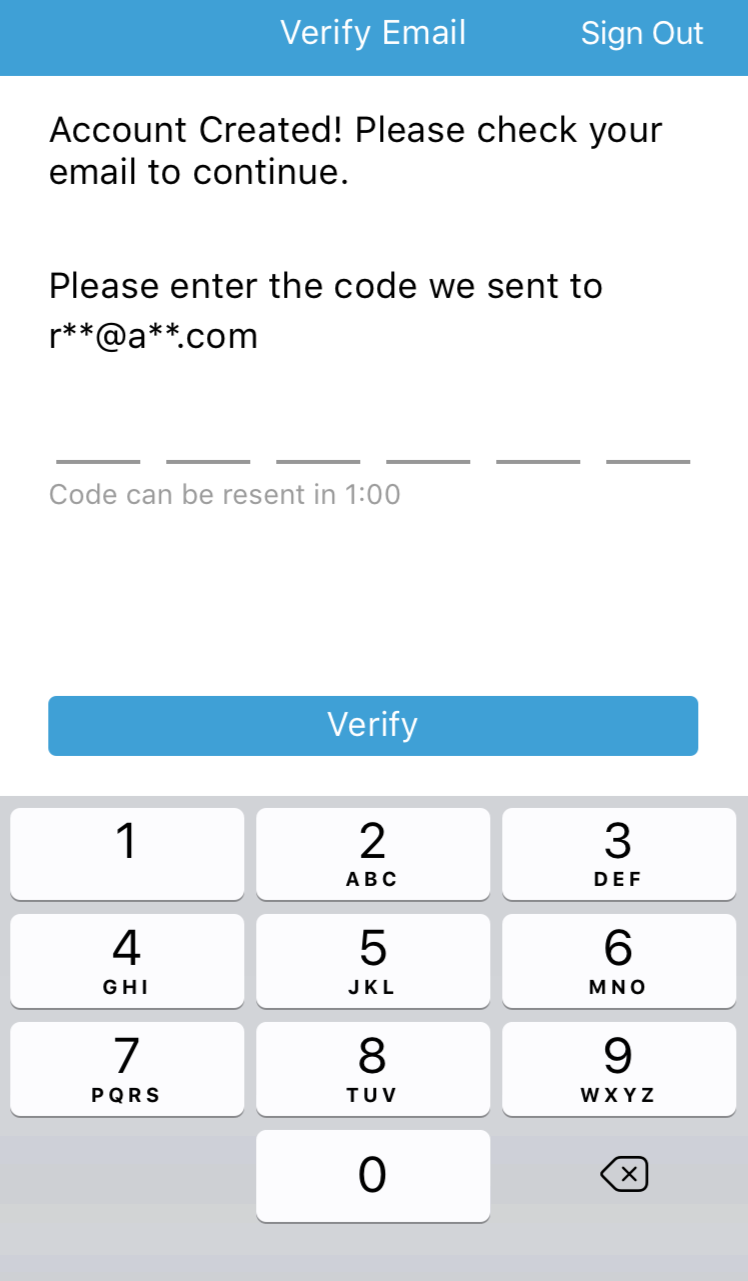
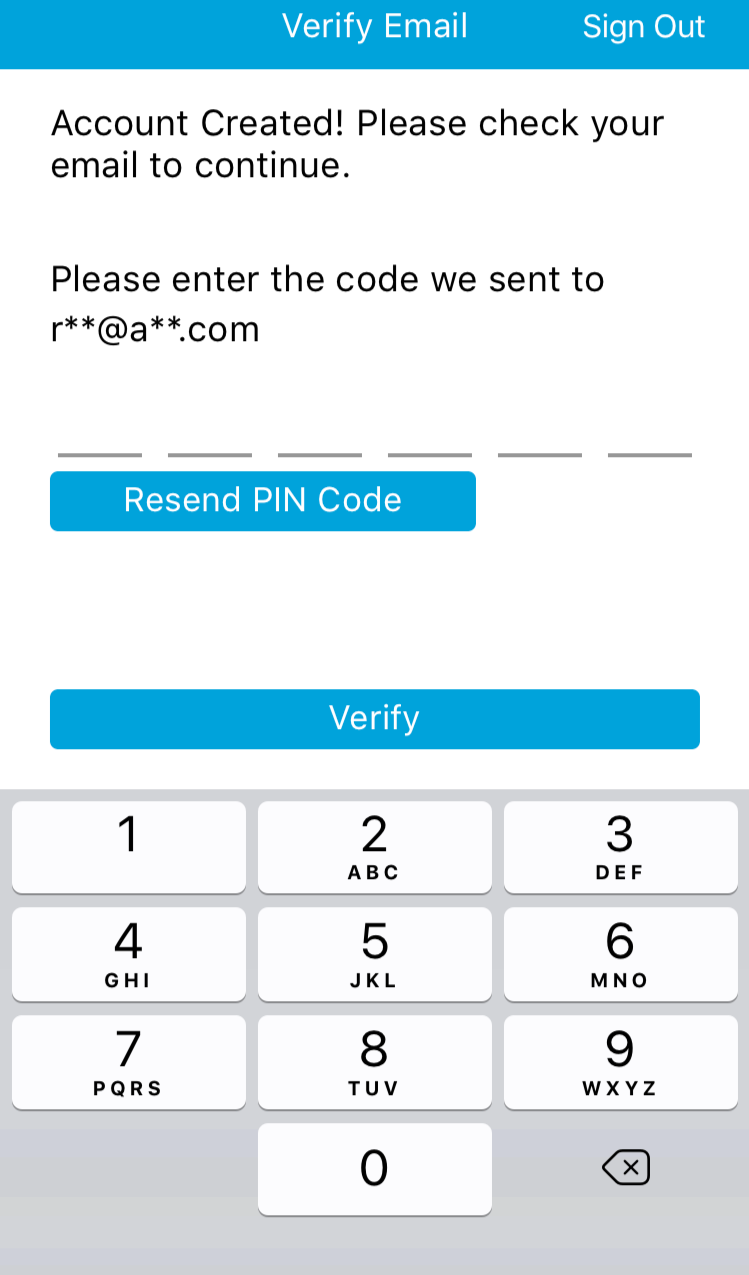
Verify your phone number
Tap the phone number entry line to bring up a keypad.
Enter the phone number you wish to use for device verification and tap Next.
Optional: Select your country code by tapping the flag icon next to the phone number entry line.
If you prefer to not use SMS, the PIN code can be read to you by an automated voice call.
To choose this option, under Receive code by: select Voice call and tap Next.
Note
The SMS text option is for use with mobile phones and will not work with landline phone numbers. Blink uses this number to positively associate your device to the Blink app to ensure the person making changes is you. Your information is private and will not be used for any additional purposes or shared with third parties.
Learn more why we need your phone number. Contact Customer Service if you don’t have a phone number.
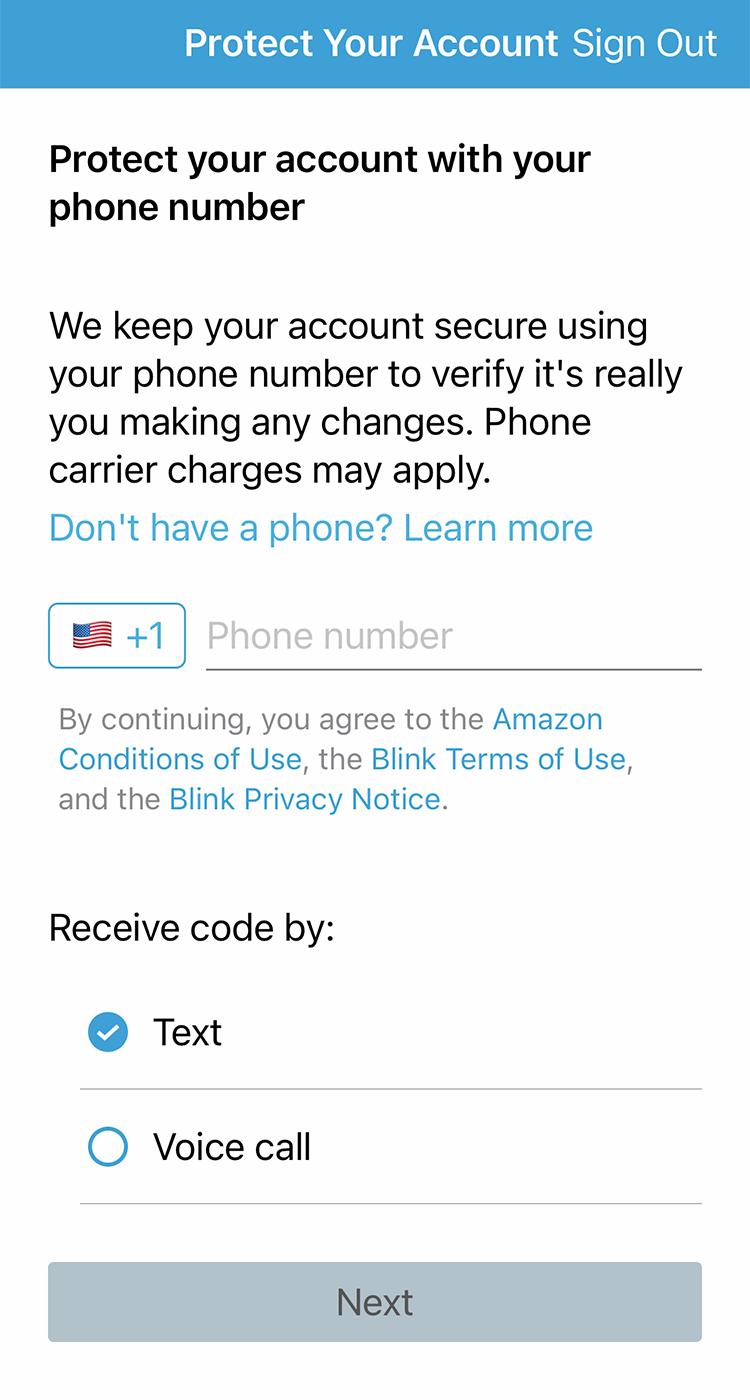
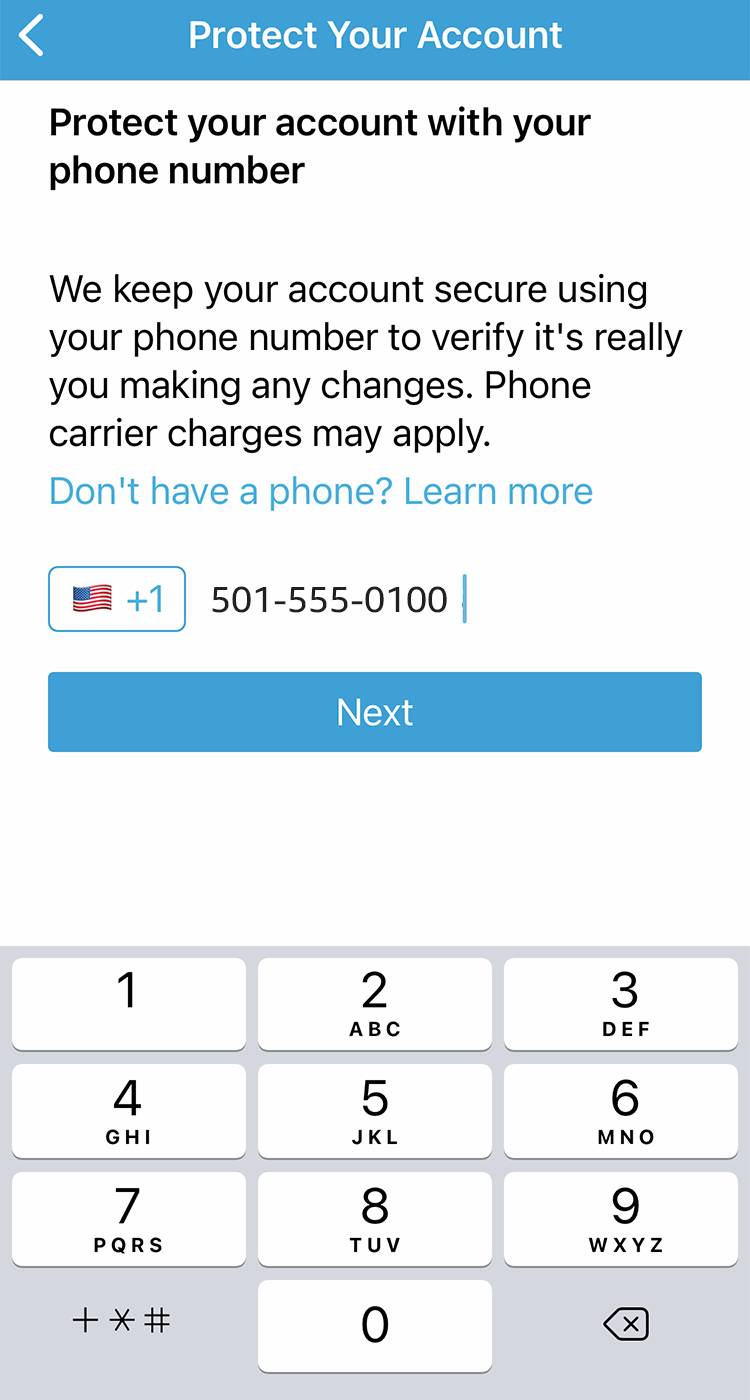
A SMS text message containing the PIN code is sent to the phone number, and you are shown another PIN entry screen.
Your Blink verification code
is: <123456>
Enter the PIN from the SMS text message we sent you and tap Verify.
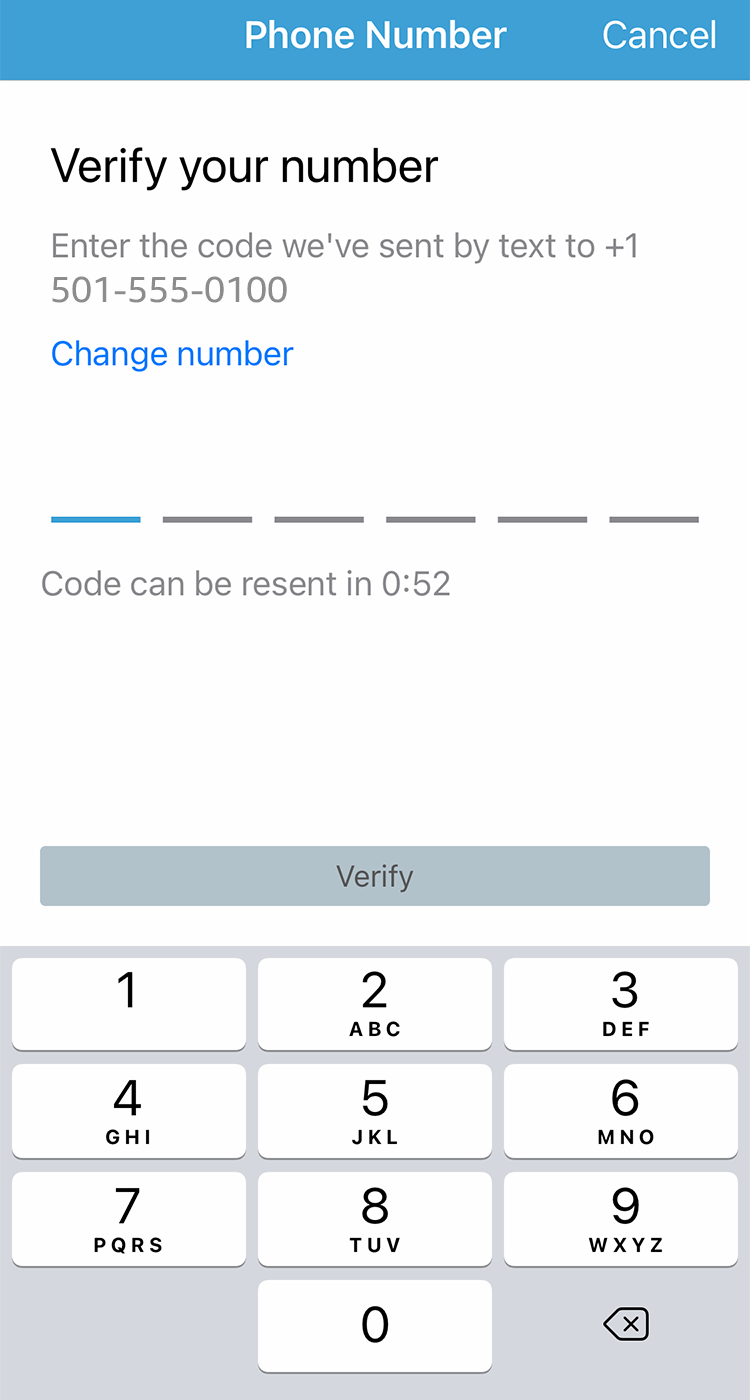
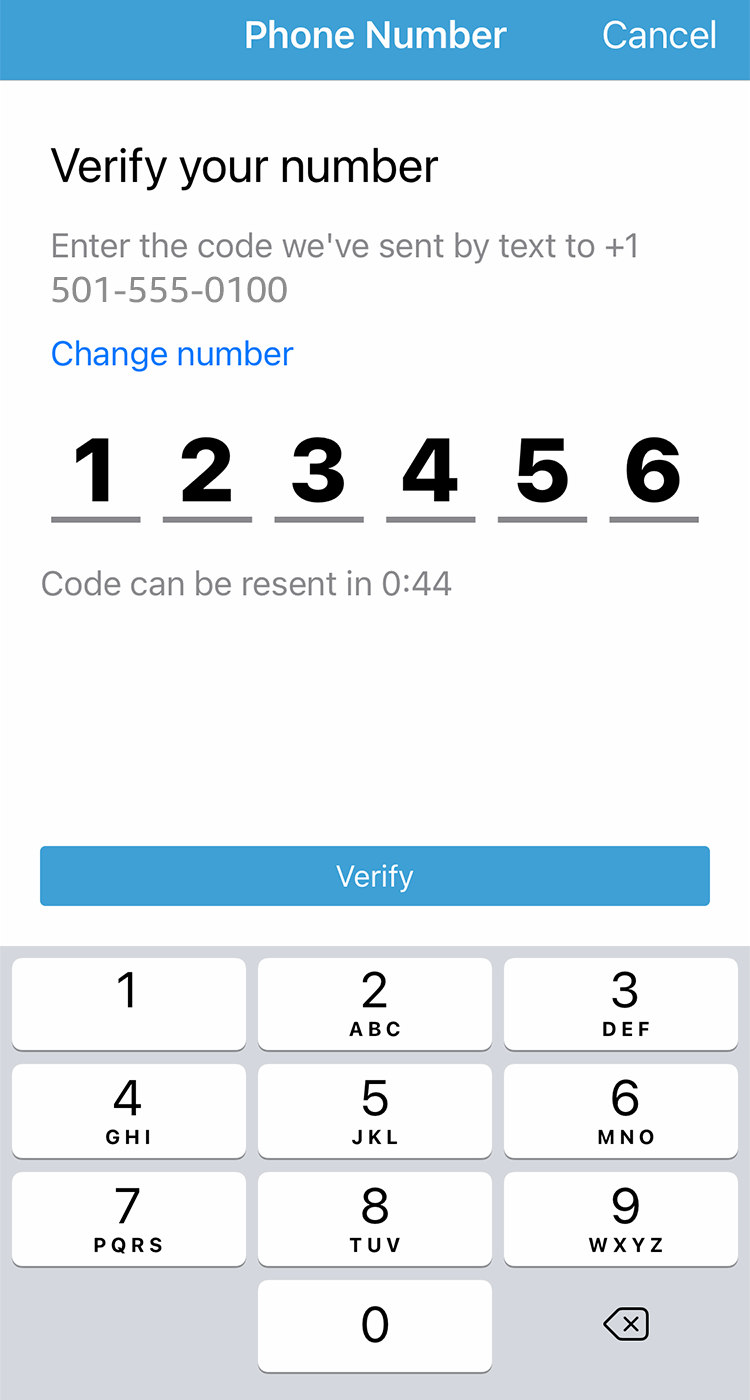
Link your Blink and Amazon accounts
When the phone verification step is complete, you are prompted to link your new Blink account to your Amazon account by tapping Link Accounts. If you don’t want to link your account, select Skip to be sent to the Home screen without linking your accounts.
Note: This is an optional step, but we highly recommend linking your accounts at this time. Learn more about the benefits of linking your accounts.
Sign into your existing Amazon account. You will need to know your Amazon login email address and password. Once the link is established between accounts, tap Next.

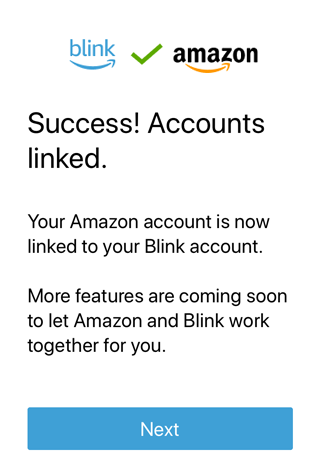
Crash Reporting Opt Out
If the Blink app suddenly stops working, recovering the data helps us understand what happened, so we can constantly improve. This “crash report” is sent from your device without any kind of information that identifies you.
You can opt out of sending crash reports on the Blink app Account and Privacy screen, and in your device’s main Settings screen for the Blink app.
Use the Enable Crash Reporting toggle on the Manage Account screen to control the sending of crash reports.
From the Blink app Home screen, tap the gear icon  to visit the Settings screen and select Account and Privacy.
to visit the Settings screen and select Account and Privacy.
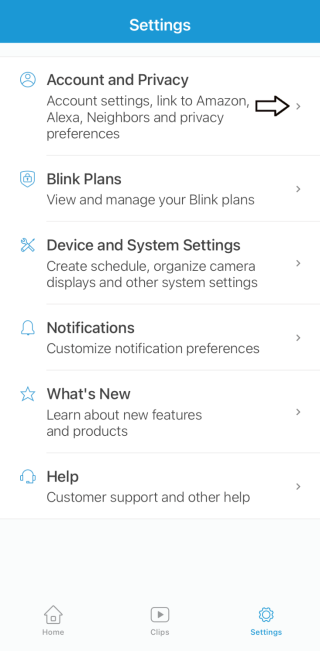
Opt-out of sending reports by tapping the Enable Crash Reporting toggle.
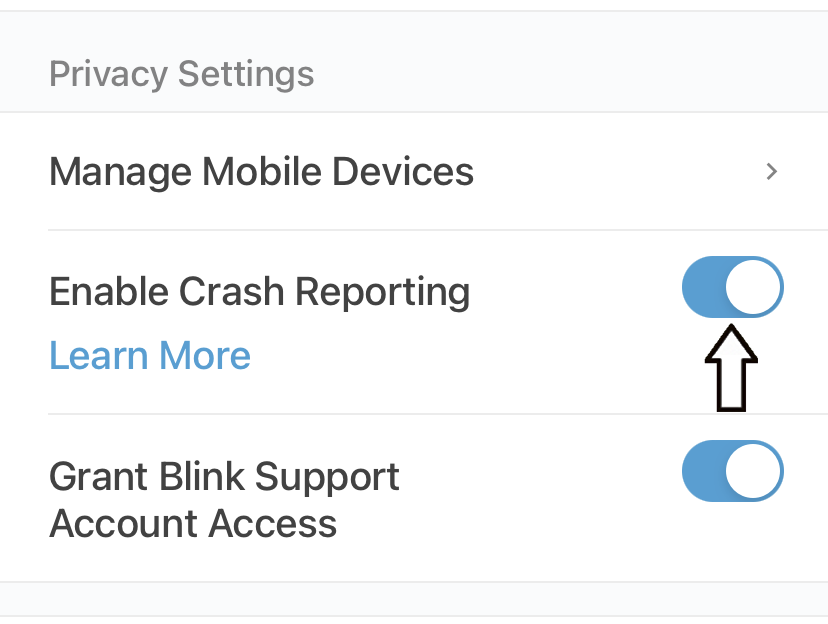
You can also control crash reporting from your device Settings screen when you select the Blink app as shown in the image.
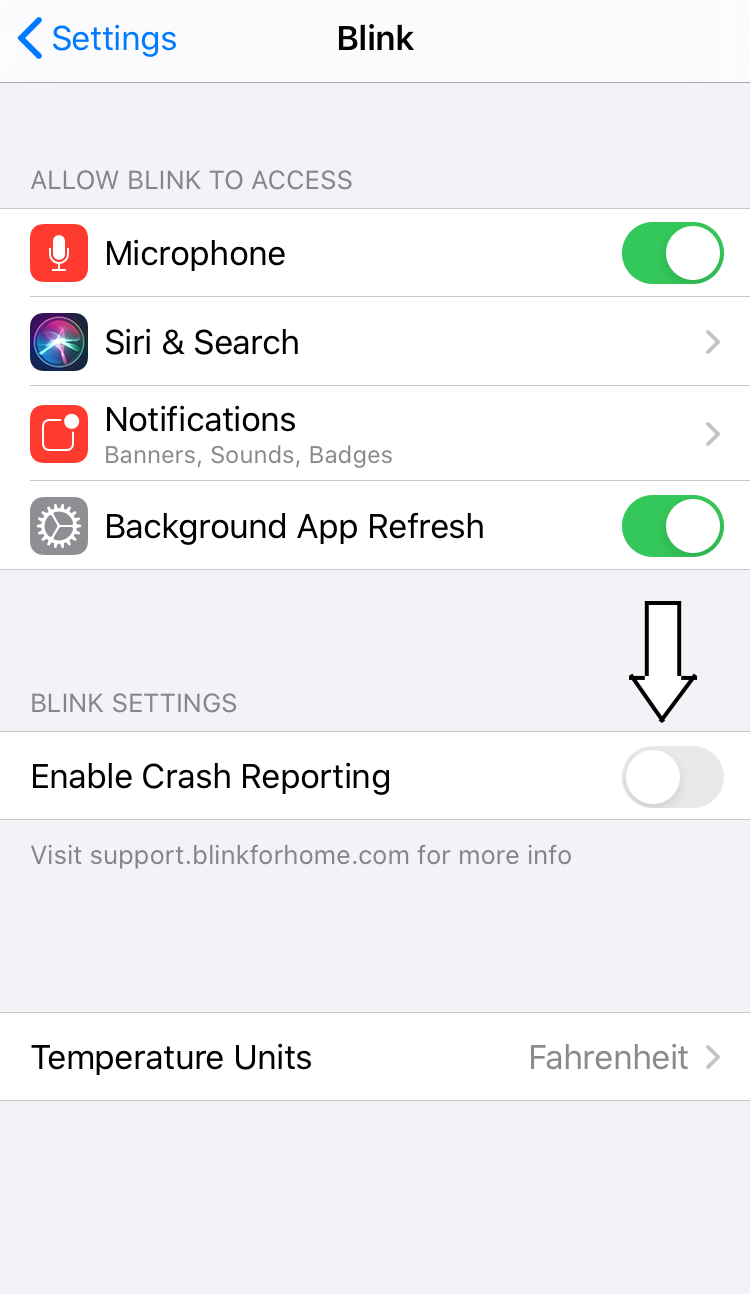
How to update your Blink account settings
How to update your email, phone number, and password in the Blink app
This article describes how to change your email, phone number, or password in the Blink app.
Before you can change your email, phone number, or password in the Blink app, you will prompted to enter your Blink account password. If you have forgotten your password, you’ll need to reset it using the Forgot password? link. Learn more about resetting your password.
What if I no longer have the phone number associated with my Blink account?
If your phone number has changed, or you can’t access the phone number associated with your Blink account, contact customer support for assistance. Please note, you must be with your Blink devices in order for customer support to assist you.
Updating your email address in the Blink app
Updating your phone number in the Blink app
Updating your password in the Blink app
How Do I Change My Blink Account Email Address?
These steps describe how to change your email address in the Blink app. Before you can change your email address in the Blink app, you will prompted to enter your Blink account password.
Note: If you have forgotten your password, you’ll need to reset it using the Forgot password? link. Learn more about resetting your password.
Once you can log in to your Blink account, follow these steps to change your Blink account email address.
 in the footer of the Blink app and then select Account and Privacy.
in the footer of the Blink app and then select Account and Privacy.Note: One email address can be used with your Blink account. If multiple users are sharing your Blink account login, they will be logged out once this is changed and will need to log back in using the updated email address.
If you are unable to access your email address, unable to change it using the steps above, or experience issues with the email updating process, contact customer service.
Securing your Blink Account with Multi-Factor Authentication
What if I no longer have the phone number associated with my Blink account?
If your phone number has changed, or you can’t access the phone number associated with your Blink account, contact customer support for assistance. Please note, you must be with your Blink devices in order for customer support to assist you.
What is Multi-Factor Authentication
At Blink, we take the security of your account seriously. That’s why we’ve implemented a two-step verification process, also known as two-factor authentication or multi-factor authentication (MFA). The extra layer of authentication helps prevent unauthorized users from gaining access to your Blink account, even if they have your username and password.
When you attempt to log in to your Blink account you’ll receive a one-time, six-digit code to verify it’s you. This is sent to your mobile device as a text message (SMS). You can choose to receive this one-time passcode via the email address you have listed on your Blink account or on your phone as a text message (SMS).
Verification codes and emails are sent directly to the main account holder, ensuring that only the authorized user has access to the account. If you want to share your account with other trusted individuals, they will need to obtain the verification codes from the main account holder. Learn more about how to set up your Blink account on another device.
If you prefer not to use SMS or don’t have a mobile phone, we have options available to ensure that you can securely access your account.
How to Grant Account Access for Blink Customer Support
Granting access
One way we protect your information is to hide your account details until you give permission for a support agent to have access. To improve your experience, we recommend making sure this option is enabled before you call technical support.
Note: Blink customer service agents are never able to see your clips or live views from a camera.
To unhide your account details for support agents:
 in the footer of the Blink app.
in the footer of the Blink app.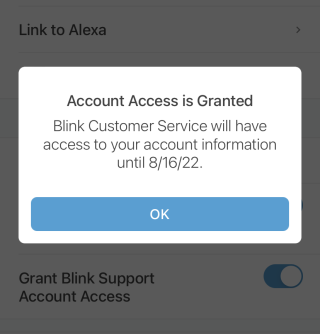
Customer support has access to your account details for 14 days. You can revoke permission at any time by tapping the switch again.
If you are not able to access your account, contact our Customer Support team.
This privacy feature is present from Blink app versions 6.1.3 (iOS) and 6.1.2 (Android and Fire OS) onward. Refer to Current Blink App Versions and Keeping Your Blink App Version Current to learn about updating your Blink app.
Blink Support contact information
Blink customer support is here for you 24 hours a day / 7 days a week.
If you are in the US or Canada and need help setting up or using your Blink system, please call 781-332-5465* or toll free 1 833-392-5465.
If you are located in Europe and need technical assistance, please call us at +44 1158 384189*
How to reset your Blink password using the Forgot Password link
Reset your forgotten password using the Forgot password? link
This article walks you through resetting your password in the Blink app.
If you’ve forgotten your password or you’re unable to log in, you will need to reset your password by tapping the Forgot password? link on the Welcome to Blink! login screen.
Note: You must tap the Password box to display the Forgot password? link.
Note: If you are already logged in and want to update your existing Blink account password, learn more about How to update your Blink account settings.
Resetting your password
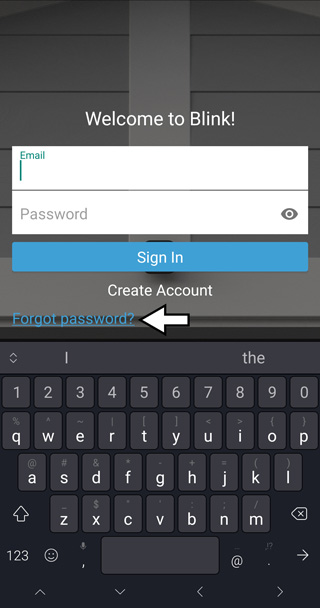
Unlinking Your Blink and Amazon Accounts
Linking your Blink and Amazon accounts allows you to see and manage all of your Blink Subscription Plans in one place. It is required in order to activate subscription plans and you can unlink your accounts at any time.
When you unlink your accounts; however, the subscription plans covering your devices(s) will be paused and they will no longer be covered by the plan’s benefits. Refunds are provided to customers with active (and paid) subscriptions that remain on pause status for 12 or more months.
If you prefer to save clips only to local storage for a certain camera or video doorbell and don’t want it covered by a Basic subscription plan, it is also necessary to unlink your accounts in order for that camera or video doorbell to be removed from your subscription plan by customer service.
How to unlink your Blink and Amazon accounts
1. Tap the Settings icon at the bottom of your screen.
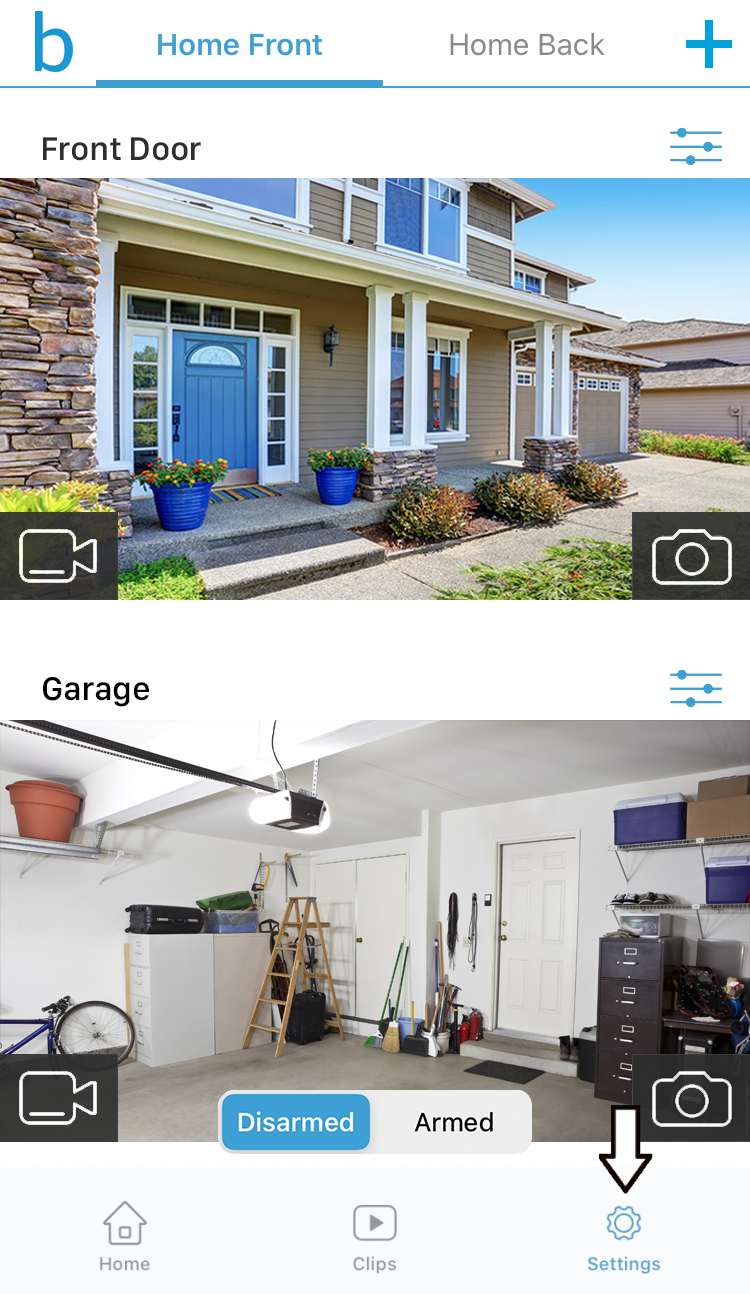
2. Select Account and Privacy.
3. Then tap Amazon Account Linked.
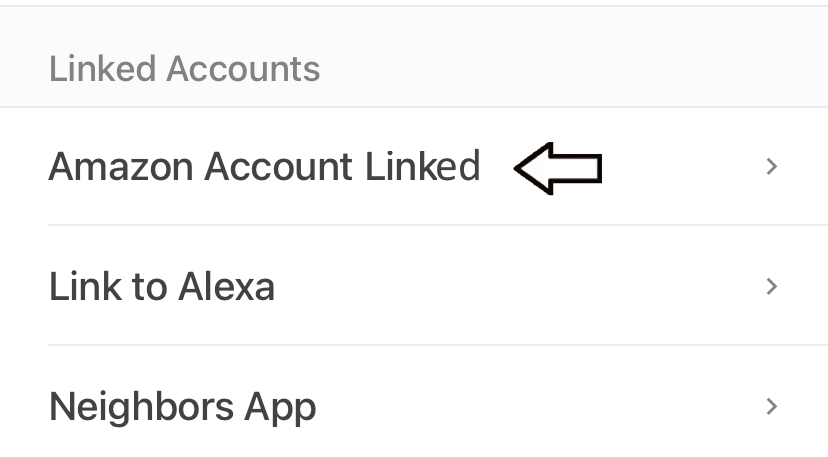
4. Next, tap on Unlink Accounts.
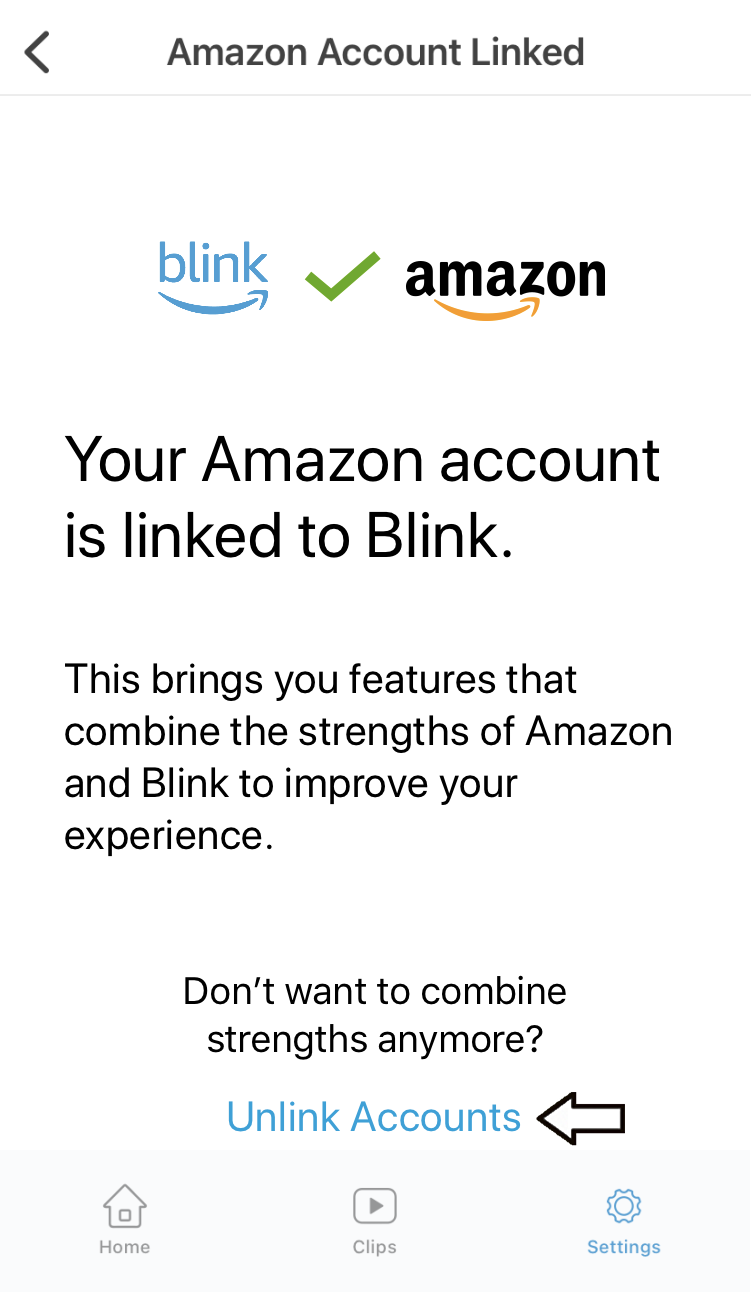
5. You will then see a warning that your subscription plan will be paused. Select Continue to proceed.
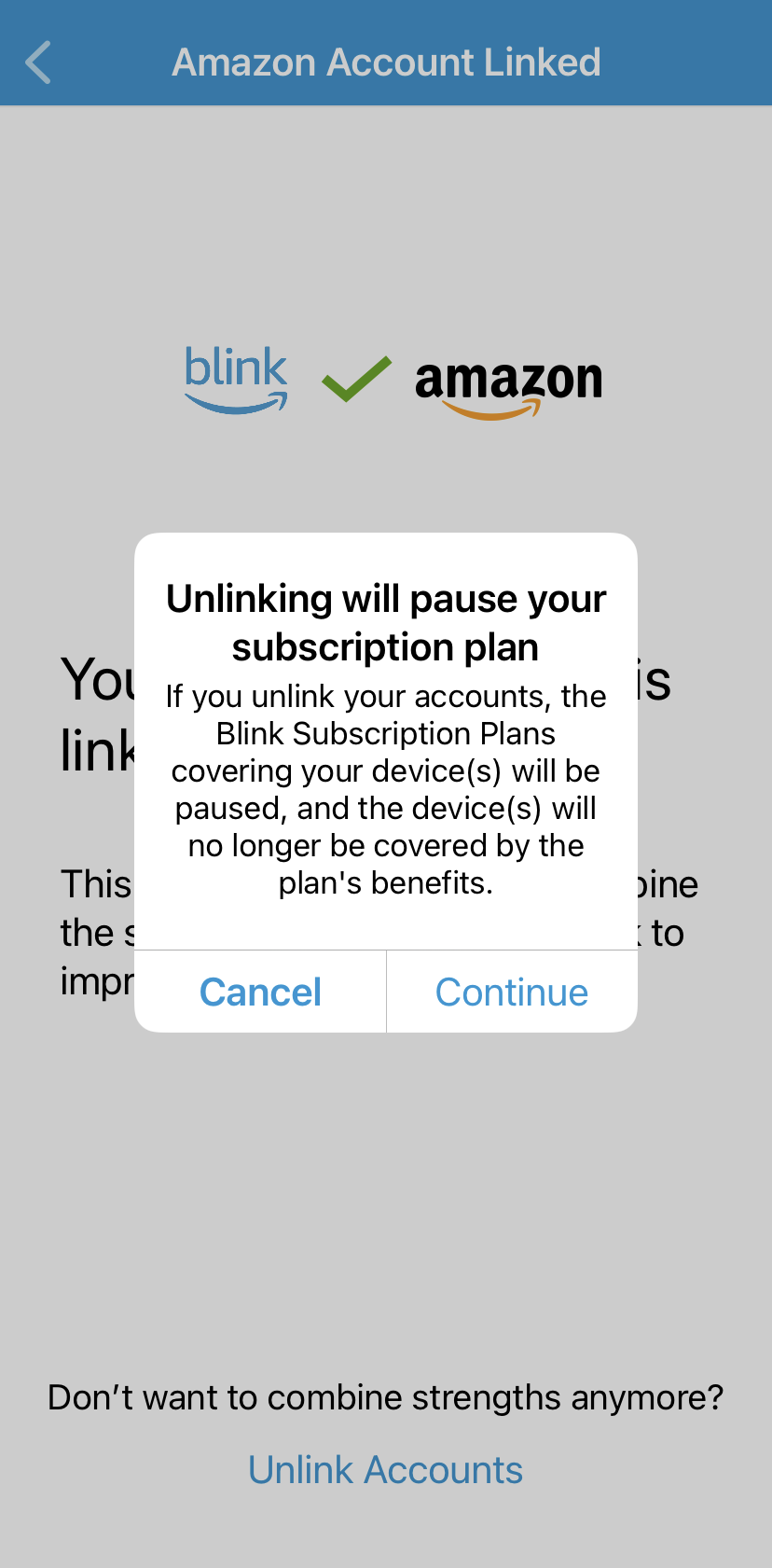
6. Next, enter your Blink password and tap Unlink.
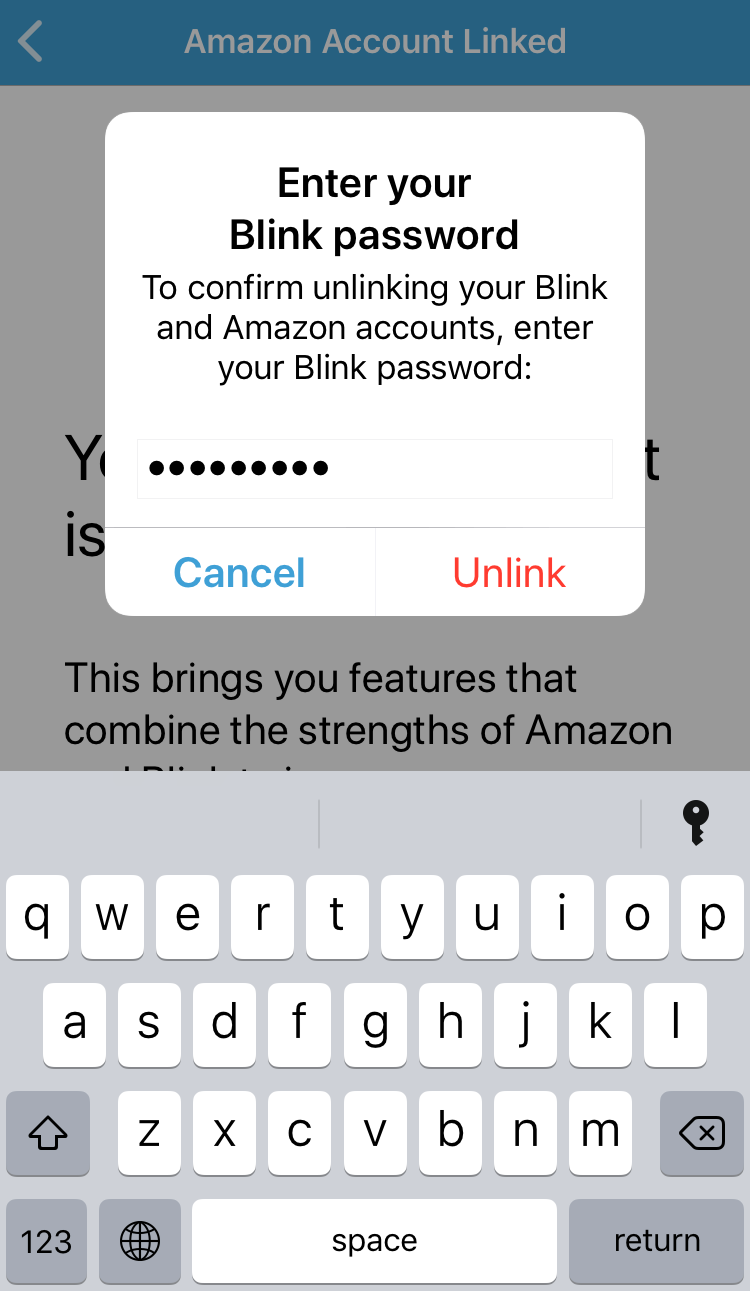
7. Your Blink and Amazon accounts are now unlinked.
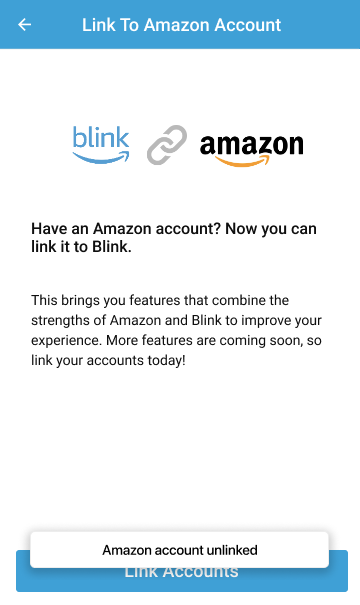
You then have the option to link both accounts again or return to the Account screen.
How do I delete Motion Clips?
Caution: Once you delete a clip, it is permanently erased from Blink’s servers and cannot be recovered by Blink Support.
Clips can be deleted in the following ways:
Automatically delete clips
When you’re subscribing to a Blink plan with Cloud Storage, clips are deleted automatically after a certain period of time. The default auto-delete period is 60 days and can be adjusted to 3, 7, 14, or 30 days (EU and UK users have 30 days maximum).
Auto-delete is available with:
Storage Settings
To change the number of days after which clips automatically delete, tap Clips > Storage Settings and select the new Auto-delete clips older than setting.
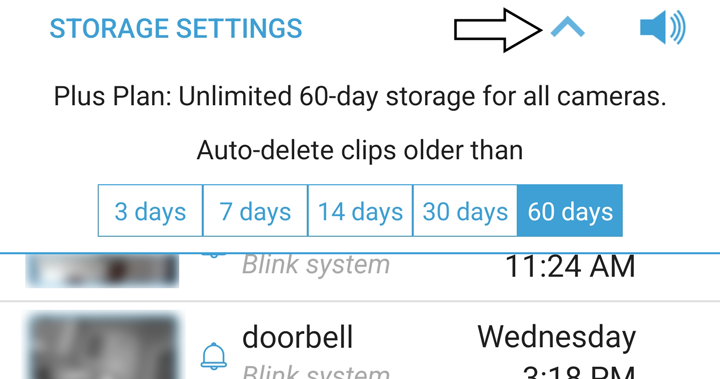
You can also access Auto Delete After within App Settings.
Note: Storage Settings is available to users on a Blink subscription plan. If you were formerly on a plan, your auto-delete Storage Settings will remain as the time you previously selected before the subscription plan expired.
Delete a single clip in the Blink app
Delete multiple clips in the Blink app
iOS
Android
Warning
Unlike single clips, the app does not prompt you to confirm multiple clip deletion before it completes the action.
Delete a clip from your USB flash drive
The USB flash drive connected to your Sync Module 2 can contain either local storage clips or clip backups. Learn more about Local Storage with Sync Module 2.
Local Storage clips
Local Storage clips can be viewed and deleted one at a time within the Blink app. Delete them the same way you delete single clips in the Blink app.
To delete more than one clip at once, safely eject the USB drive from your Sync Module 2, and move it to a computer to access clip files directly. Delete the clips using the operating system of your computer.
Clip Backups
If you have an active subscription plan and are using a Sync Module 2 with USB flash drive to store clip backups, these backups can’t be viewed or deleted in the Blink app. Instead, safely eject the drive from your Sync Module 2, and move it to a computer. Delete the clips using the operating system of your computer.
How to share or save Clips in the Blink App
Use this article for understanding how to share or save your motion clips using the Blink app.
These instructions work for any clip that you can view in the Clips section of the app.
Sharing clips
Saving clips
Viewing Motion Clips in the Blink app
View, mark as viewed, or filter motion clips
Learn how to view motion clips, mark clips as viewed, and filter motion clips for a optimum viewing experience within the Blink app.
Your camera(s) starts recording motion clips after your Blink system is armed. Once motion is recorded, you can view motion clips in the Blink app.
Clip storage locations
When you use Blink cameras, motion clips can be stored in three different locations.
Motion clips are separated by tabs within Clips. If there is only one section that appears in Clips (no tabs), your clips are only found in that storage location.
How to view your stored clips

How to mark clips as viewed
Single or multiple clips can be selected and marked as viewed without actually viewing them. This will remove the orange dot next to the clip.
Note: Marking clips as viewed will be reflected on all other user’s devices who share that account.
iOS
Android
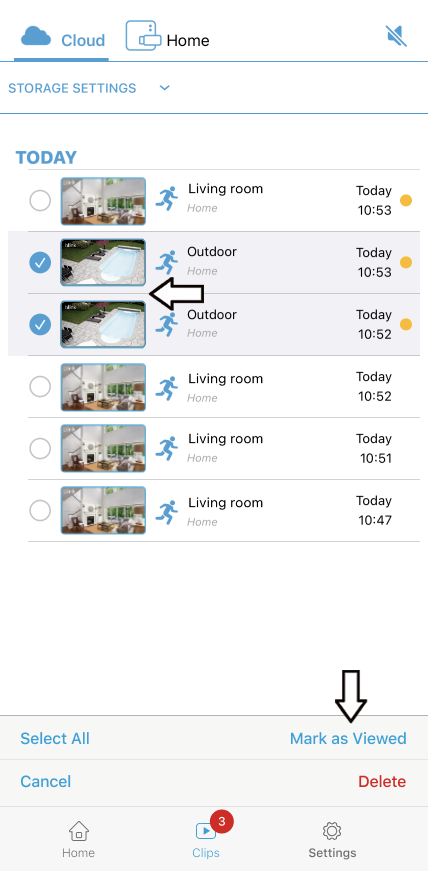
How to filter clips
The more clips you have, the more time it will take to sort through the clips you want to see. Fortunately the Blink app offers a way to filter different types of clips, clips from a certain system, or clips from certain cameras. The default view shows all clips from all your cameras on all the systems that are available.
This feature is exclusive to accounts attached to Blink subscription plans, within trial periods or accounts created before April 16, 2020. Edit and filter options are not available when using only Local Storage. Learn about Blink subscription plans and how they work with cloud storage.
Filtered results
Once you’re done setting up your desired filter, tap Done to return back to Clips.
○Filter means the default view is showing all clip types, all systems, and all cameras.
●Filter shows that a filter is active. Tap ●Filter to change the filter settings.
How To Save Live View Clips
Note: We’ve enhanced the design of the Blink app. If the steps listed in this article do not match your current app version, you can view the updated design.

Info
Saving all clips, whether they’re Live View or otherwise, requires a Blink Subscription Plan or a free trial.
Live View allows you to see what the camera is currently capturing and monitor the scene as it happens, rather than viewing a recorded version of the event.
Here are the Blink Cameras that support saving Live View clips:
Live View clips are never saved or backed up to Local Storage. This includes Live View sessions accessed from Alexa devices like an Echo Show (no Local Storage option).
XT2 camera Live View clips take more storage space than motion clips, so be aware of your 7200 second storage limit. When the limit is reached, your oldest clip will be automatically deleted to make room for the newest one. Learn more about how clips are deleted.
XT and Indoor (generation 1) cameras do not allow you to save Live View clips.
Here’s how to save Live View as a clip.
1. From the Home screen, tap the Live View icon located in the lower left corner of each camera.
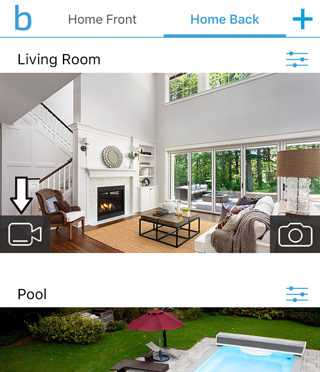
2. On the Live View screen, Save in the lower left indicates the current session is saved to Cloud Storage for that camera. Tap this icon to enable or disable saving the Live View session. The Save icon changes whether saving is active or inactive.
Tap Save to enable saving the Live View session.
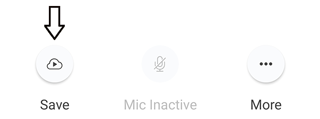
The icon changes and a message appears confirming the current Live View session is saved to Cloud Storage.
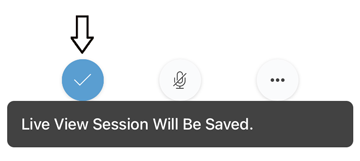
Save icons
Note: When Save all Live Views is enabled in your Blink App Settings, Save is on by default for each time you enter a Live View session. You can turn off saving the Live View session at any time by tapping Save.
Tap the Clips section in the footer of the Home screen.
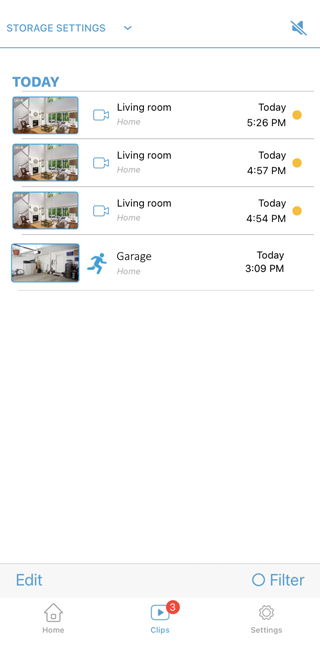
Note: Any deleted clips are permanently removed from our systems and cannot be recovered.
This setting allows you to automatically save a Live View session to Cloud Storage any time you access Live View through a camera.
1. Tap App Settings ![]() in the footer of the app and select Device and System Settings.
in the footer of the app and select Device and System Settings.
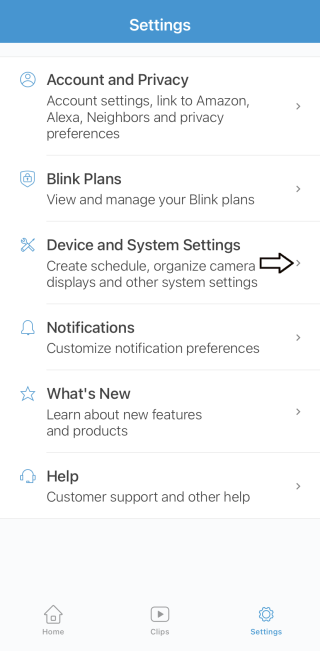
2. Under Systems, select the system name by tapping it.
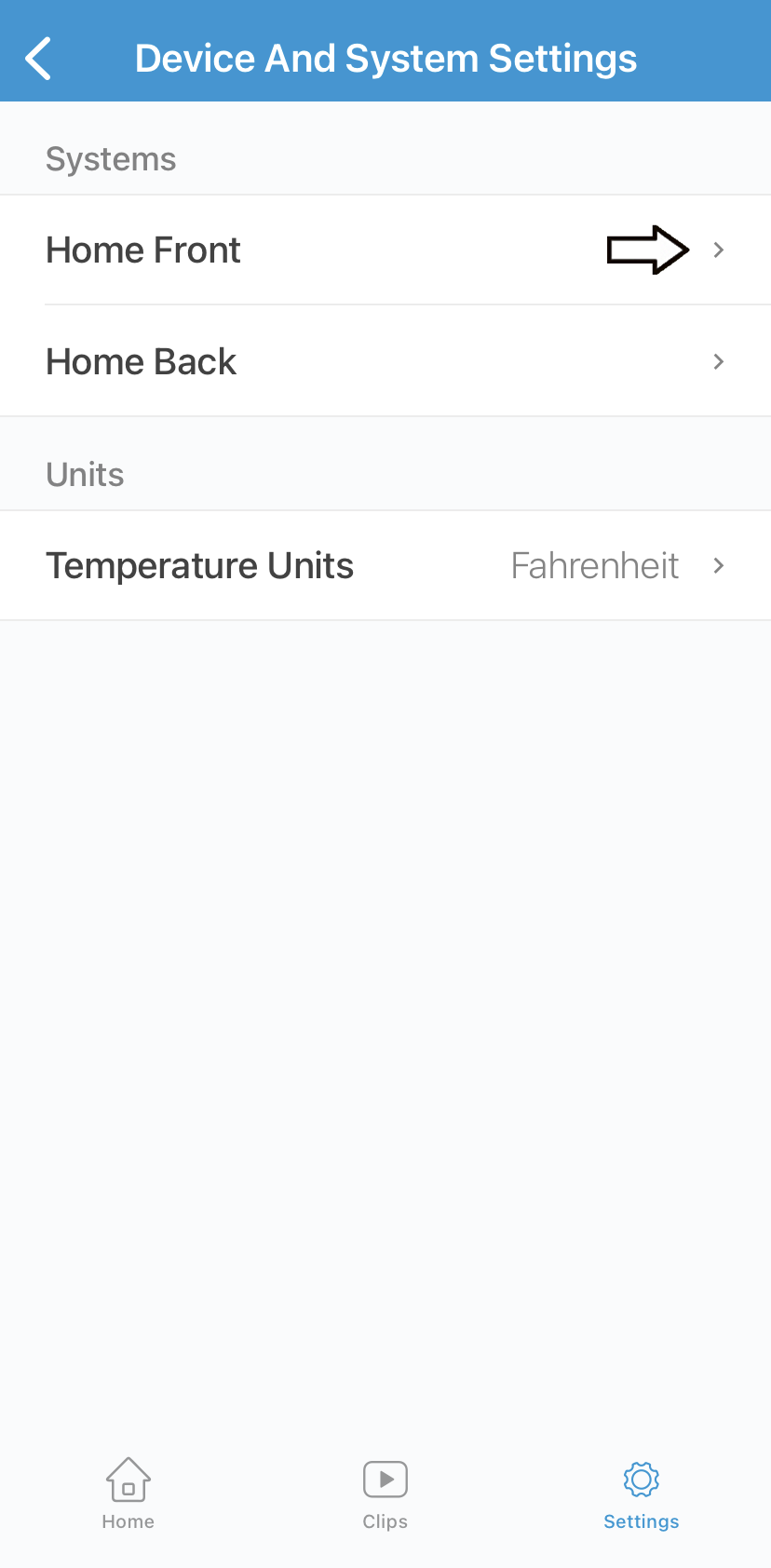
3. Tap Save all Live Views and Live View events for the system selected above will now be saved in Cloud Storage.
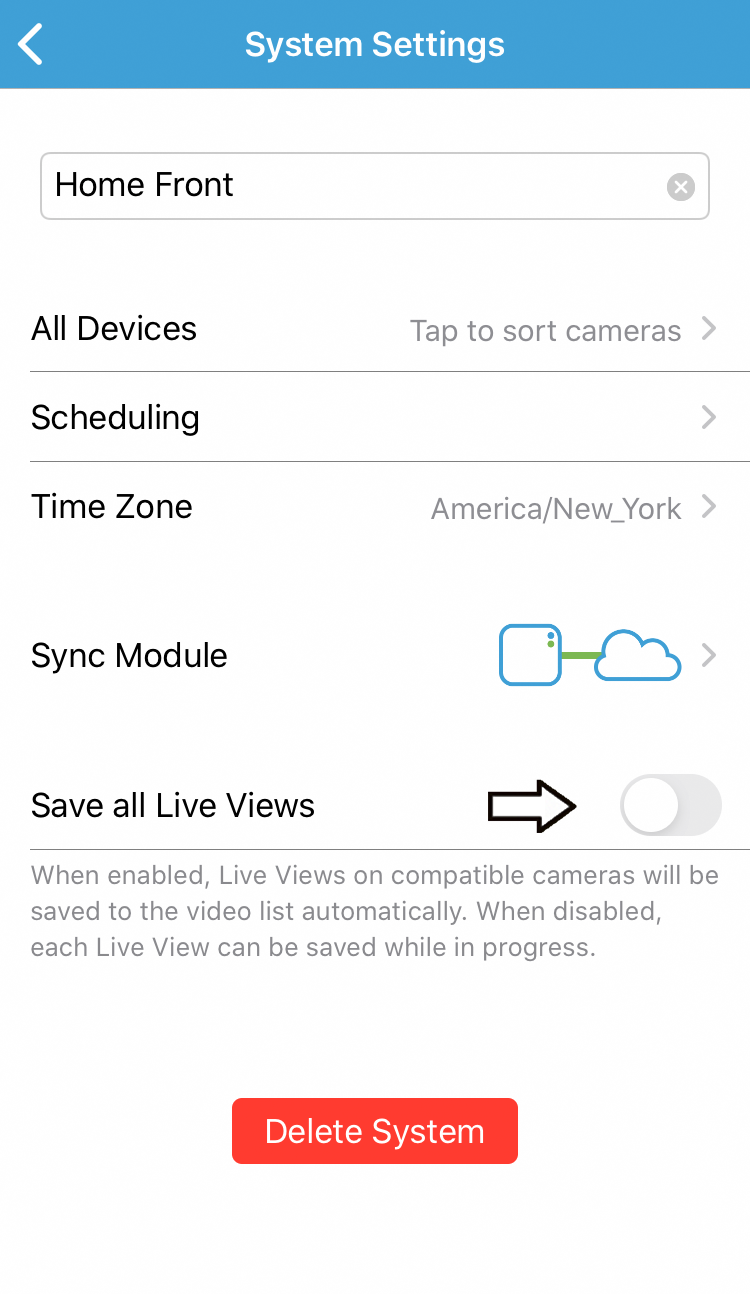
Saving Live Views with Alexa
When you have a Blink subscription and use an Alexa-enabled device to open the Live View session, the entire session is saved unless you stop it manually.
To start a live view from your Blink camera, say:
“Alexa, show [camera name].”
To stop a live view, say:
“Alexa, stop.”
“Alexa, end.”
“Alexa, exit.”
“Alexa, go home.”
“Alexa, hide [camera name].”
Note: Live view commands work with compatible Alexa-enabled screen devices.
How do I view backup clips?
Viewing Clip Backup from a USB drive
Clip Backup occurs when you insert a USB drive into your Sync Module 2 and you have one of the following:
The Clip Backup feature is available for the Wired Outdoor 4, Floodlight Camera, Video Doorbell, Outdoor and Indoor (3rd Gen), and the Mini. Learn more about Blink Subscription Plans.
Once every 24 hours, a backup of your Cloud Storage clips are saved to the storage device plugged into your Sync Module. To access the backup files, the USB storage device must be removed from the Sync Module 2 and inserted into a computer or similar device.
Note: Backup clips are not viewable from the Blink app.
Warning – if your drive is full
When your USB flash drive has less than 375MB of storage space, Local Storage clips and backup clips are no longer saved. To free up space, delete clips, format your USB drive, or insert a new USB drive into the Sync Module.
Safely Eject the USB
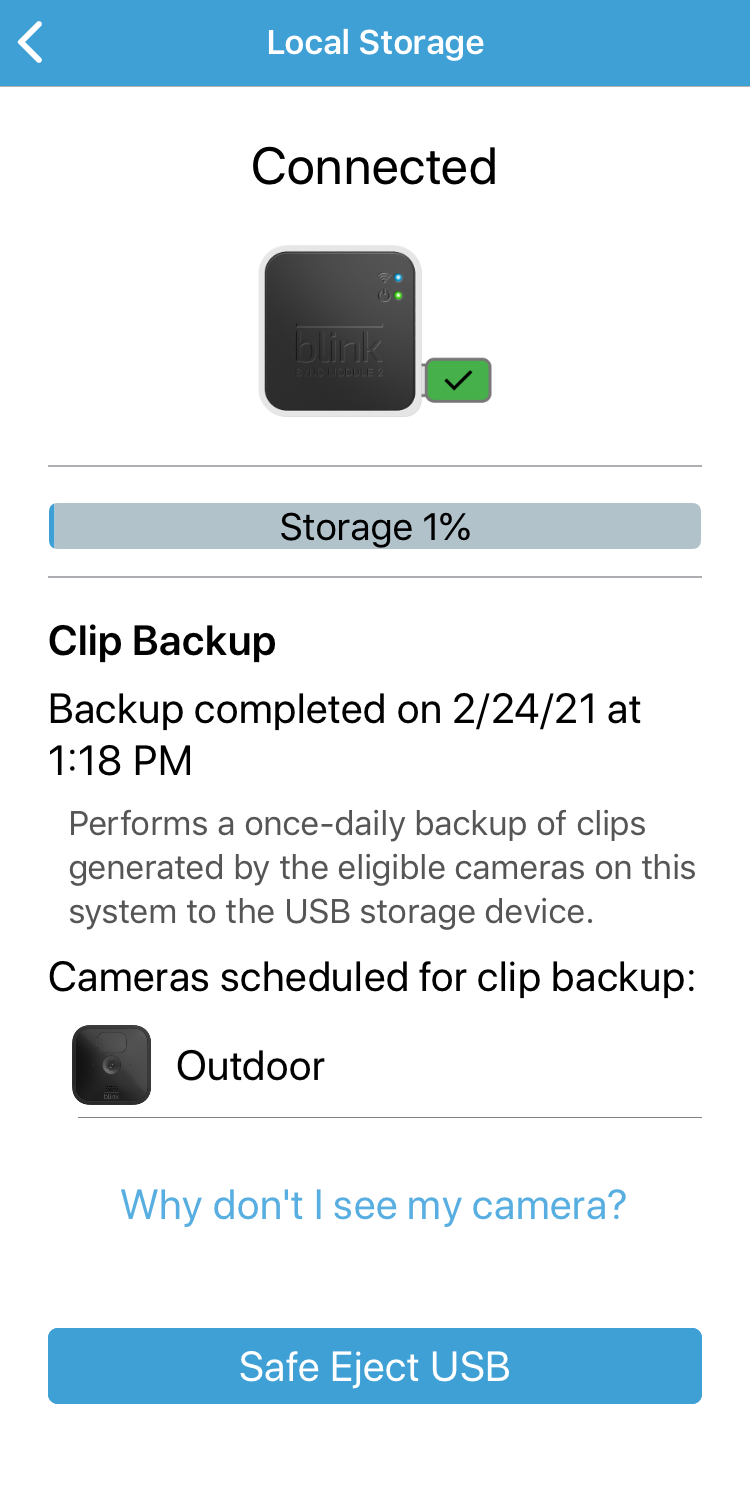
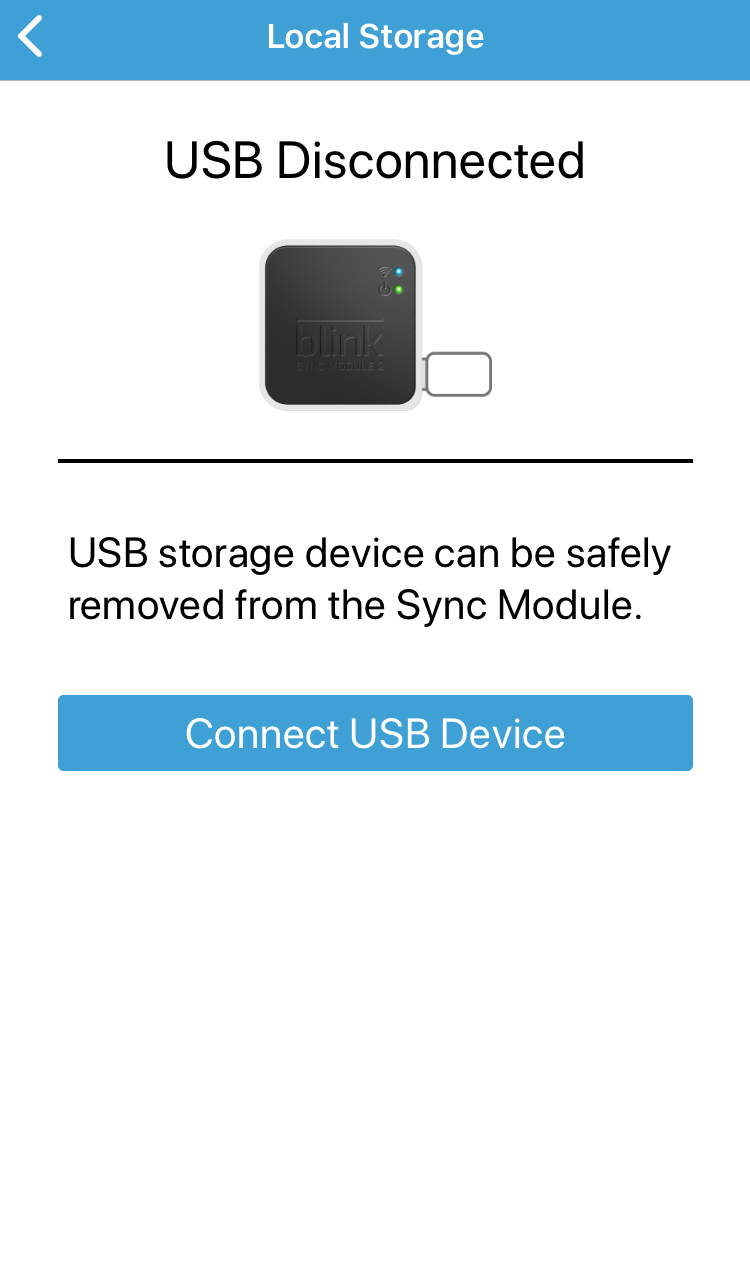
How to view Backup Clips

Example

blink_backup – This folder contains backup clips from eligible cameras.
20-09 – This folder indicates a two digit year 20 for 2020, and two-digit month 09 for September.
01-20-21-38_Outdoor_1234567.mp4 – File name is generated using this convention: [Day of month] – [Hour (in 24-hour format)] – [Minutes] – [Seconds] _ [camera-name] _ [camera UID].mp4
How do I view backup clips?
Viewing Clip Backup from a USB drive
Clip Backup occurs when you insert a USB drive into your Sync Module 2 and you have one of the following:
The Clip Backup feature is available for the Wired Outdoor 4, Floodlight Camera, Video Doorbell, Outdoor and Indoor (3rd Gen), and the Mini. Learn more about Blink Subscription Plans.
Once every 24 hours, a backup of your Cloud Storage clips are saved to the storage device plugged into your Sync Module. To access the backup files, the USB storage device must be removed from the Sync Module 2 and inserted into a computer or similar device.
Note: Backup clips are not viewable from the Blink app.
Warning – if your drive is full
When your USB flash drive has less than 375MB of storage space, Local Storage clips and backup clips are no longer saved. To free up space, delete clips, format your USB drive, or insert a new USB drive into the Sync Module.
Safely Eject the USB
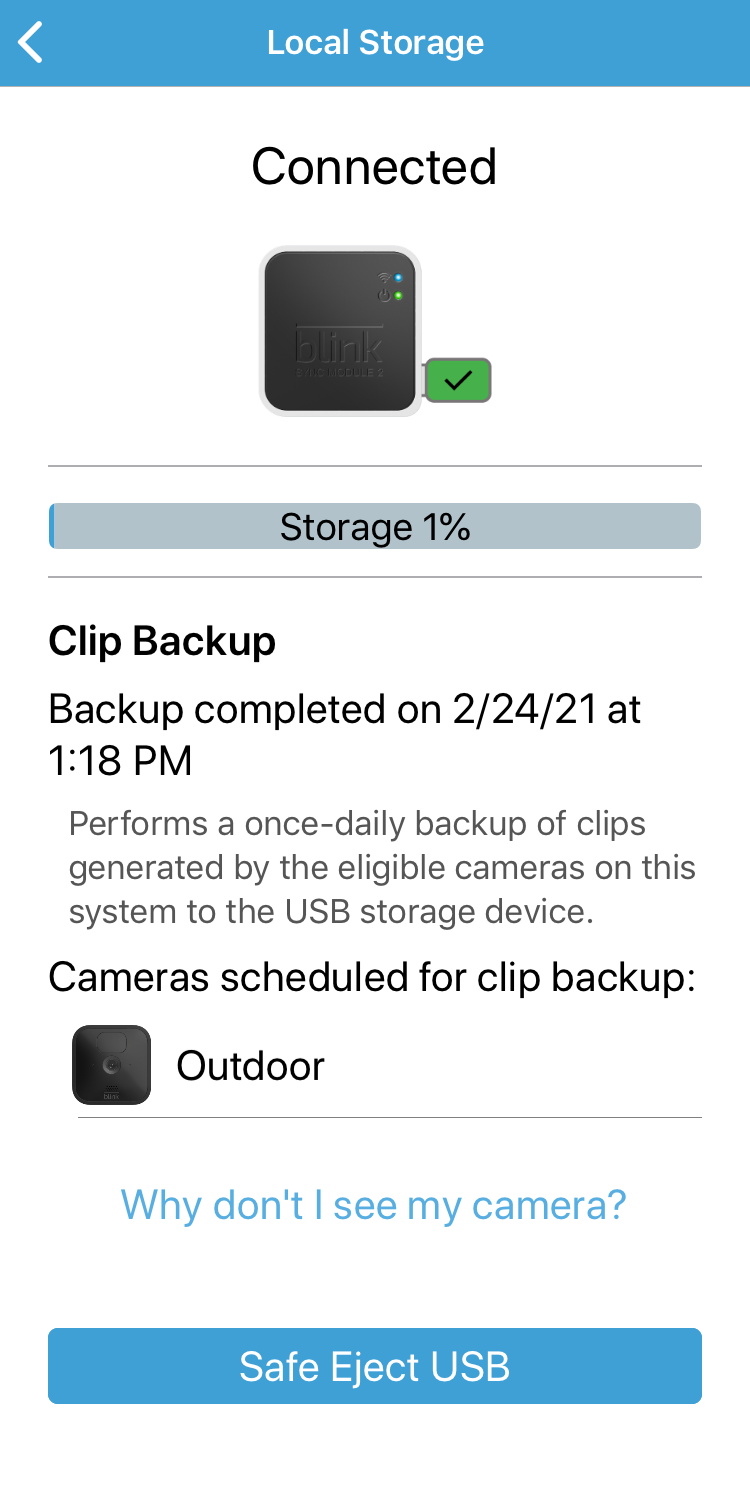
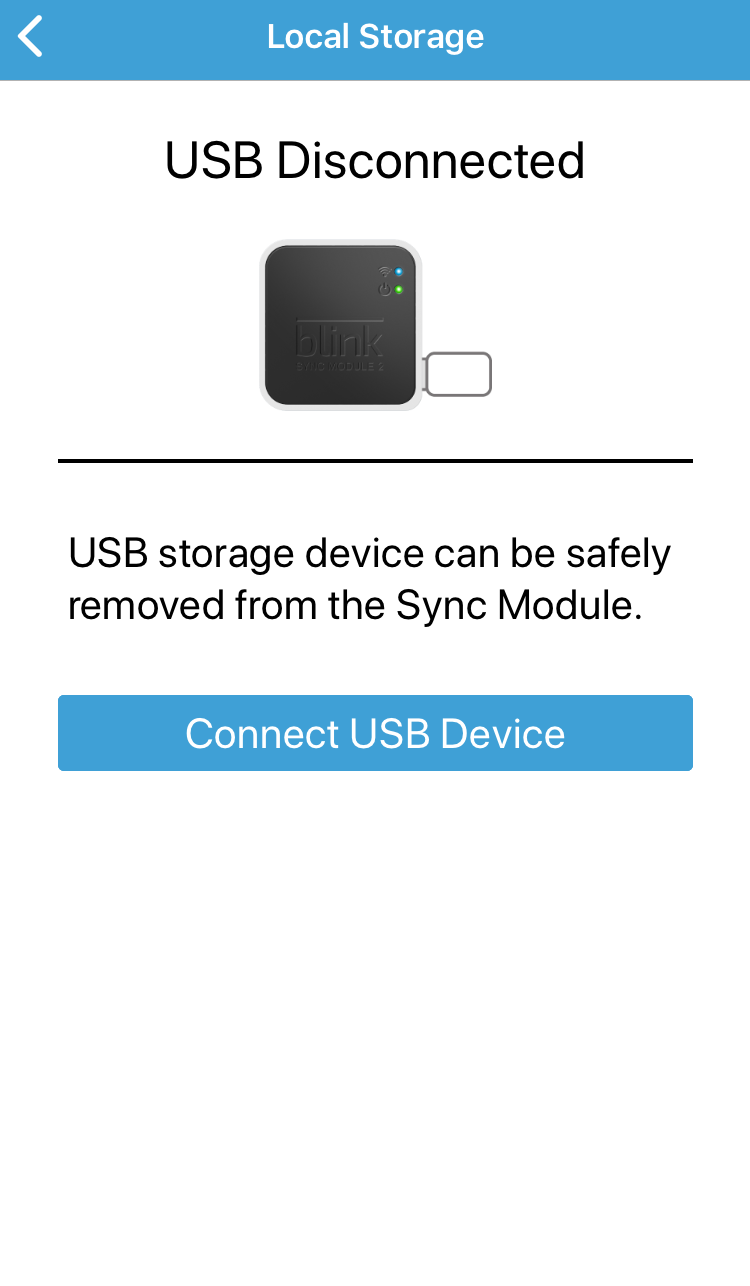
How to view Backup Clips

Example

blink_backup – This folder contains backup clips from eligible cameras.
20-09 – This folder indicates a two digit year 20 for 2020, and two-digit month 09 for September.
01-20-21-38_Outdoor_1234567.mp4 – File name is generated using this convention: [Day of month] – [Hour (in 24-hour format)] – [Minutes] – [Seconds] _ [camera-name] _ [camera UID].mp4
Accessing clips on your USB drive from a PC
Use this article to learn how to access the motion clips saved to your USB flash drive.
Types of clips
The Sync Module 2 uses the USB drive in one of two ways:
Local Storage – If you are not subscribing to a Blink Subscription Plan, motion clips are saved to the drive. These clips are known as Local Storage clips.
Clip Backup – If you are subscribing to a Blink Subscription Plan, motion clips are backed up to the drive every 24 hours from the moment it is plugged in. These clips are known as backup clips.
Warning – If your drive is full
When your USB flash drive has less than 375MB of storage space, Local Storage clips and backup clips are no longer saved.
To free up space, delete clips, reformat your USB drive, or insert a new USB drive into the Sync Module.
Always follow the Safe Eject process in the Blink app before physically removing your USB drive from your Sync Module 2.
Plug the USB flash drive into a PC
Insert your USB drive into a computer and access the flash drive as you normally would. Clips are viewed using any media player that supports the common MP4 format, such as VLC, Windows Media Player, or QuickTime Player.

Folder names on the flash drive
Your clips can be saved in two folders on your USB flash drive named blink and blink_backup.
Local Storage
Backup Clips
Local Storage clips are found on the USB drive in the blink folder. The subfolders within this folder correspond to the date when the clips were saved.
Example

blink – This folder contains clips from eligible cameras.
21-05 – This folder indicates a two digit year 21 for 2021, and two-digit month 05 for May.
21-05-02 – This folder indicates a two digit year 21 for 2021, a two-digit month 05 for May, and a two-digit date 02 for the second day of the month.
12-54-30_BlinkMini_001.mp4 – The filename shows: [Hour (in 24-hour format)] – [Minutes] – [Seconds] _ [Camera Name] _ [Clip Number].mp4
Troubleshooting Motion Clips Saved in Local or Cloud Storage
Here are some common issues regarding motion clips (video).
If you’re new to Blink, we recommend first learning about viewing your clips in the Blink app.
Caution: Once you delete a clip, it is permanently erased from Blink’s servers and cannot be recovered by Blink Support.
Troubleshooting Cloud Storage or Local Storage Clips
My camera is recording motion clips when there isn’t any motion.
If your camera is recording motion clips when no movement occurs, you may need to adjust the camera or its settings. Consider these factors for optimal motion clip capture.
Adjusting Sensitivity for your Blink Camera
Your Blink camera captures motion based on heat moving across the camera’s field. The total size of heat objects and amount of motion together cause a motion event. Your camera’s Sensitivity setting adjusts how much input it takes to send you a notification.
Low sensitivity is less responsive, so a larger amount of heat and motion are needed to cause a notification. The highest setting may cause alerts from blowing leaves or even shadows.
If you are receiving too many notifications with nothing interesting, try turning the Sensitivity down two points. If that is effective, test by arming the system, and walking in the field of view when Motion Detection is on, to make sure a human sized object will trigger a notification.
Be careful if you tap the notification and enter Live View with your microphone or speakers on, significantly loud feedback may occur. Tap mute speaker in the upper right corner of the Live View.
Each camera has an individual sensitivity setting. You can find this in the Camera Settings for each camera in your system.
Choosing High or Low Sensitivity
The sensitivity setting on your camera not only depends on what is making the movement, but how long the movement is occurring.
The motion can be a big or small object, or a lot of small objects. Motion detection depends on where the object is in relation to the camera lens. For example, a bird flying close to the camera can be perceived as bigger than the person walking on the sidewalk in the distance. A person walking directly toward the camera will produce less motion than a dog walking left to right across the camera’s field of view. It’s about the amount of motion that’s occurring within the detection zone of the camera and not necessarily how large the object is.
Testing sensitivity for your home camera
How to adjust Retrigger time
Adjusting the time between motion event recording
This article describes how to adjust the retrigger time for your Blink camera.
Retrigger time is the amount of time between the end a motion capture and beginning of a new motion event. During the retrigger time, your camera does not record motion events.
By default, the system will capture a five second clip, and wait for the retrigger time of 30 seconds. If motion continues, the camera will capture another five second clip. Retrigger time can be adjusted under Device Settings.
Note: Each camera in your system has an individual retrigger time setting.
Adjusting the Retrigger time
Test your setting
After your camera’s retrigger time is set, Arm your Blink system and walk through the camera’s field of view. You’ll receive a motion notification on your mobile device. Continue to walk through the camera’s field of view to produce a second motion notification. If the retrigger time was too short or too long between captured clips, return to Device Settings and adjust the Retrigger time.
Arming and Disarming your Blink System for Motion Detection
Note: We’ve enhanced the design of the Blink app. If the steps listed in this article do not match your current app version, you can view the updated design.

When you first set up your Blink system, your system is Disarmed by default.
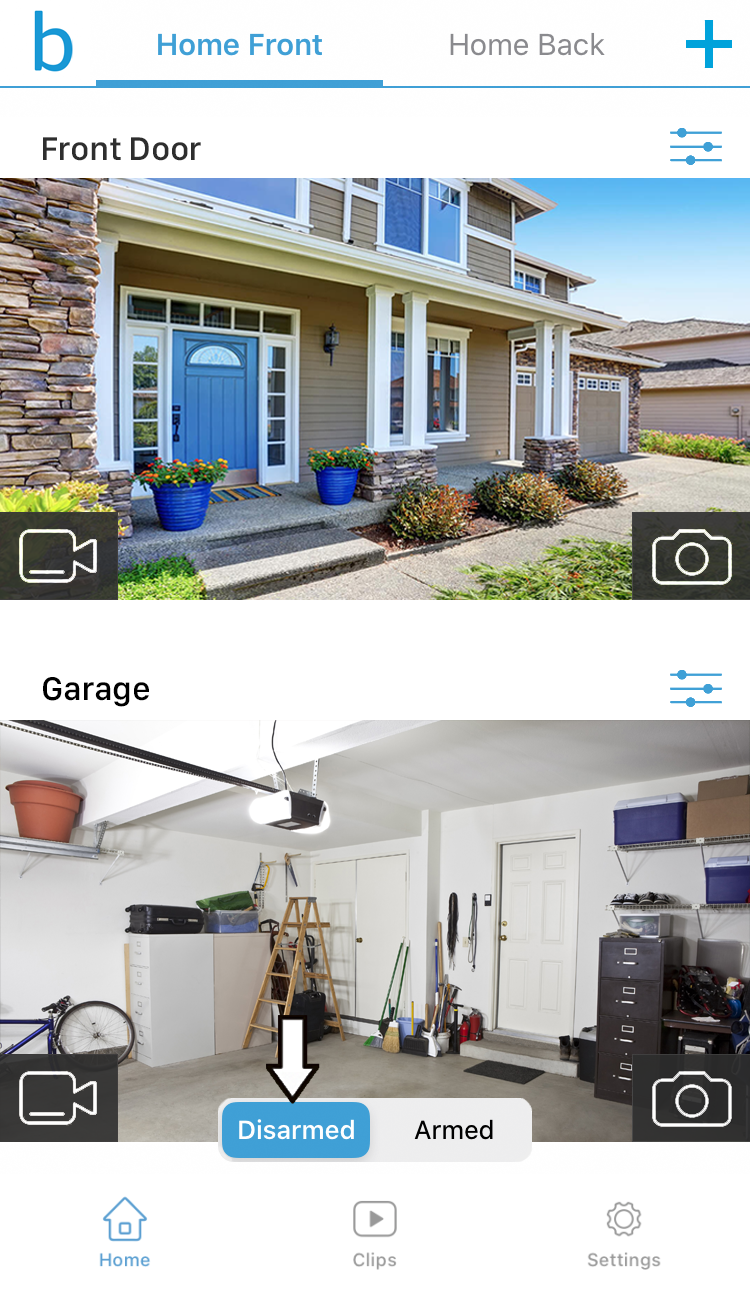
Arm your system by tapping Armed in the middle lower part of the Blink app.
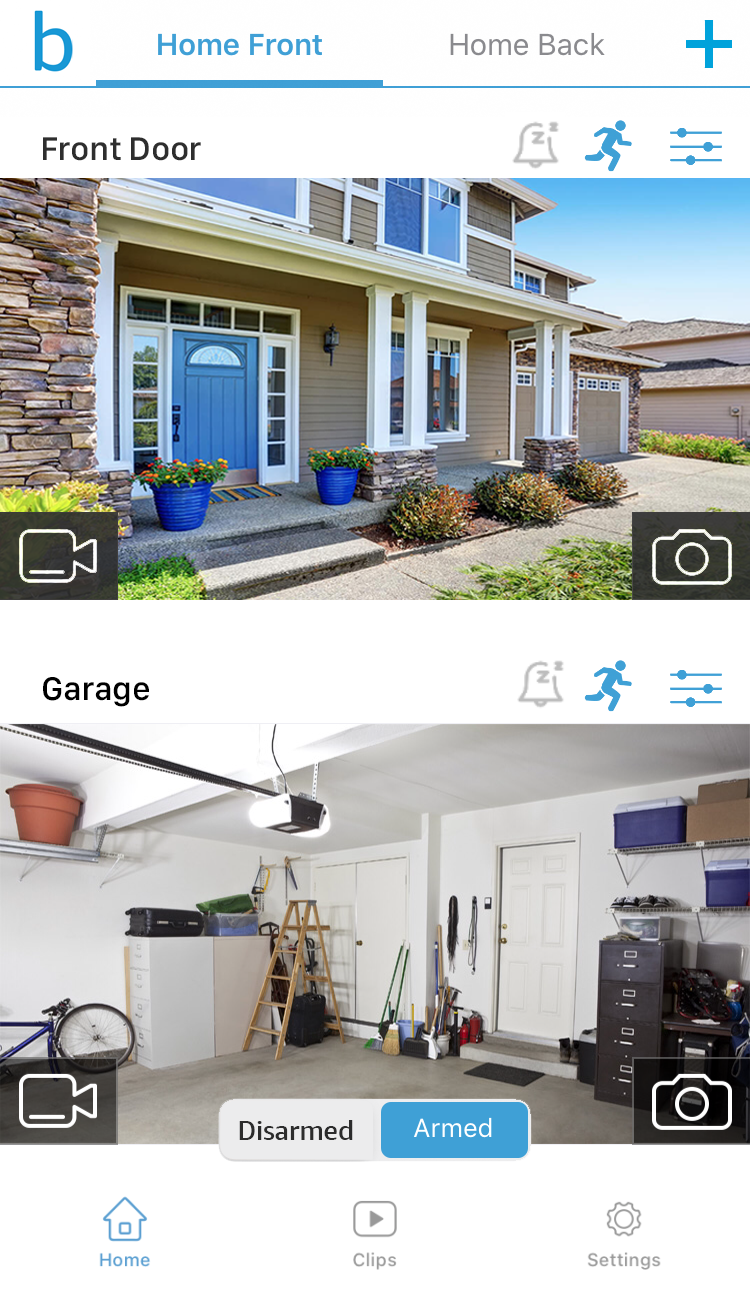
Armed system camera icons
When your system is Armed, two icons appear. The Snooze icon  and the Running man
and the Running man ![]() .
.
Early Notification
When Early Notification is enabled, the camera sends the alert when motion is first detected.
When Early Notification is not enabled, Motion Alerts are sent after the Motion Clip is saved.
The amount of time ‘earlier’ you receive an Early Notification depends upon your Clip Length settings and other factors like network speeds.
The Early Notification option is only available for the following Blink devices:
Early Notification is enabled by default and can’t be turned off on the Blink Outdoor 4, Wired Floodlight and Video Doorbell.
Why would I use Early Notification?
A real advantage of Early Notification is being able to enter Live View if you tap the Motion Alert notification, when you’re within the time frame of that clip length, or five seconds after. In this way, you can be interacting with visitors using two-way voice, or viewing whatever triggered the motion alert, within a few seconds of receiving your notification.
Note: If you pass the five second time frame after the clip has ended, you will be automatically taken to the clip list screen with no clip selected.
Can I save the Live View session?
If you have an active Blink Subscription Plan and your camera supports recording the Live View session, a “Save / Discard ” toggle appears in the live view. When the toggle is set to “Save”, the current session records until the timeout, or when you stop the Live View by tapping “Close”.
How do I use Early Notification?
To enable Early Notification, go to the camera settings screen and select Motion Settings. Then switch on Early Notification.
Early Notification is off by default for Blink cameras, as shown in the image.
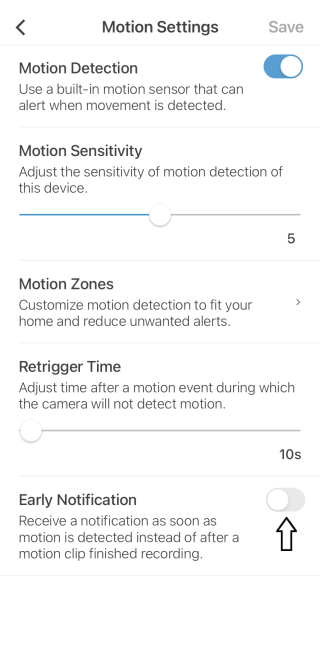
Understanding Motion Detection
Note: Before you Enable Motion Detection on your camera, you must first arm your Blink system. Once you arm your Blink system and Enable Motion Detection, you will then receive motion notifications on your mobile device. This article describes how to manage the Motion Detection feature for your Blink camera.
How Blink cameras detect motion
Blink cameras use either Passive Infrared (PIR) or Pixel Difference Analysis (PDA) to detect motion. Both technologies provide similar motion detection. Blink cameras detect motion best from about 7 to 19 feet (2m to 6m) away, and can respond to motion at 30 feet (10m). Other factors affect what motion is detected like camera placement, object size, and temperature.
Motion Detection using Passive Infrared (PIR) sensors
Blink Outdoor 4, Wired Floodlight, Outdoor and Indoor (3rd Gen), Blink Indoor (1st Gen), XT2, XT
The Passive Infrared (PIR) sensor detects heat energy from anything in the view. To detect movement, a special lens exaggerates activity across the sensor. PIR can be sensitive to groups of motion, like sunlight and shadows through a tree, blowing leaves, or rain.
PIR is most sensitive to motion moving across the field of view. Objects that are the same apparent temperature as the background may not be detected when they move. PIR sensors also work well with the Night Vision IR light in Blink cameras.
Motion Detection using Pixel Difference Analysis
Blink Mini
Pixel Difference Analysis (PDA) compares every frame of video to the next one, looking for a certain amount of difference. The amount of change needed to make a Motion Detection event is controlled with the Sensitivity setting in the Blink app. Low sensitivity means it is harder to make a motion detection event. High sensitivity responds to small amounts of motion.
Mini cameras have been used to detect motion through glass. Remember, this is not the most accurate way to detect motion, but these tips will help.
Note: The Mini camera was not designed to detect motion through glass and your results may not be consistent.
Motion Settings
Motion Settings allow you to customize how your Blink camera detects motion. Located in Device Settings ![]() for each camera, you can control motion detection, zones, retrigger time, and more. Visit the New Device Layout Settings article for a complete list of motion settings for your Blink camera. Note: Before you Enable Motion Detection on your camera, you must first arm your Blink system.
for each camera, you can control motion detection, zones, retrigger time, and more. Visit the New Device Layout Settings article for a complete list of motion settings for your Blink camera. Note: Before you Enable Motion Detection on your camera, you must first arm your Blink system.
How to Snooze motion-activated notifications
Note: We’ve enhanced the design of the Blink app. If the steps listed in this article do not match your current app version, you can view the updated design.

Use this article to understand how to use Snooze for motion-activated notifications. The Snooze option allows you to temporarily pause motion event notifications being sent to your mobile device.
For example, if you are receiving too many motion notifications from your camera you can temporarily stop receiving all motion notifications. The camera; however, will continue to record clips.
Since Snooze is on a timer, it will automatically disable the pause after the desired length of time is reached.
Turning on Snooze Notifications
 appears next to the Running Man icon (Motion Detection)
appears next to the Running Man icon (Motion Detection)  and the bell turns solid blue
and the bell turns solid blue . A message displays asking you to choose how long you want the Snooze to last. Select 30 minutes or up to 4 hours.
. A message displays asking you to choose how long you want the Snooze to last. Select 30 minutes or up to 4 hours.Turning off Snooze Notifications
 . Tap an active snooze to end it early. A confirmation message displays the amount of Snooze time remaining. You can tap the X in the upper-right hand corner to continue the active snooze or select End Snooze.
. Tap an active snooze to end it early. A confirmation message displays the amount of Snooze time remaining. You can tap the X in the upper-right hand corner to continue the active snooze or select End Snooze. .
.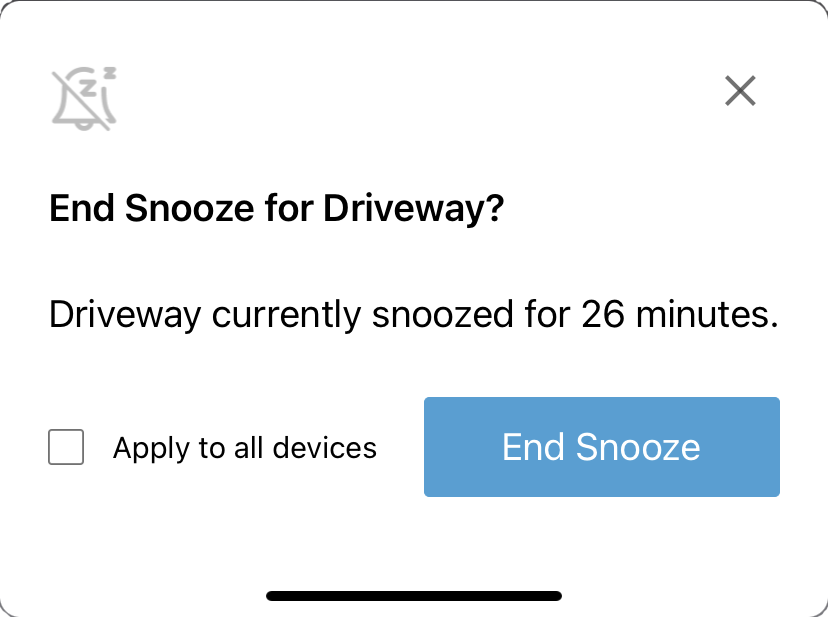
Alexa Snooze Notifications
Alexa will continue announcing events even if you have turned on Snooze notifications for your camera or system. To turn off Alexa Motion Announcements, follow these steps:
If you want Alexa to resume announcing motion notifications, you must turn on Motion Announcements in the Alexa app.
Setting a custom Snooze notification
When you have a Blink Subscription Plan or trial, you can set Custom times up to 24 hours. Learn more about Blink Subscription Plans extra features and benefits for your devices.
1. Tap Snooze  on the home screen and select Custom.
on the home screen and select Custom.
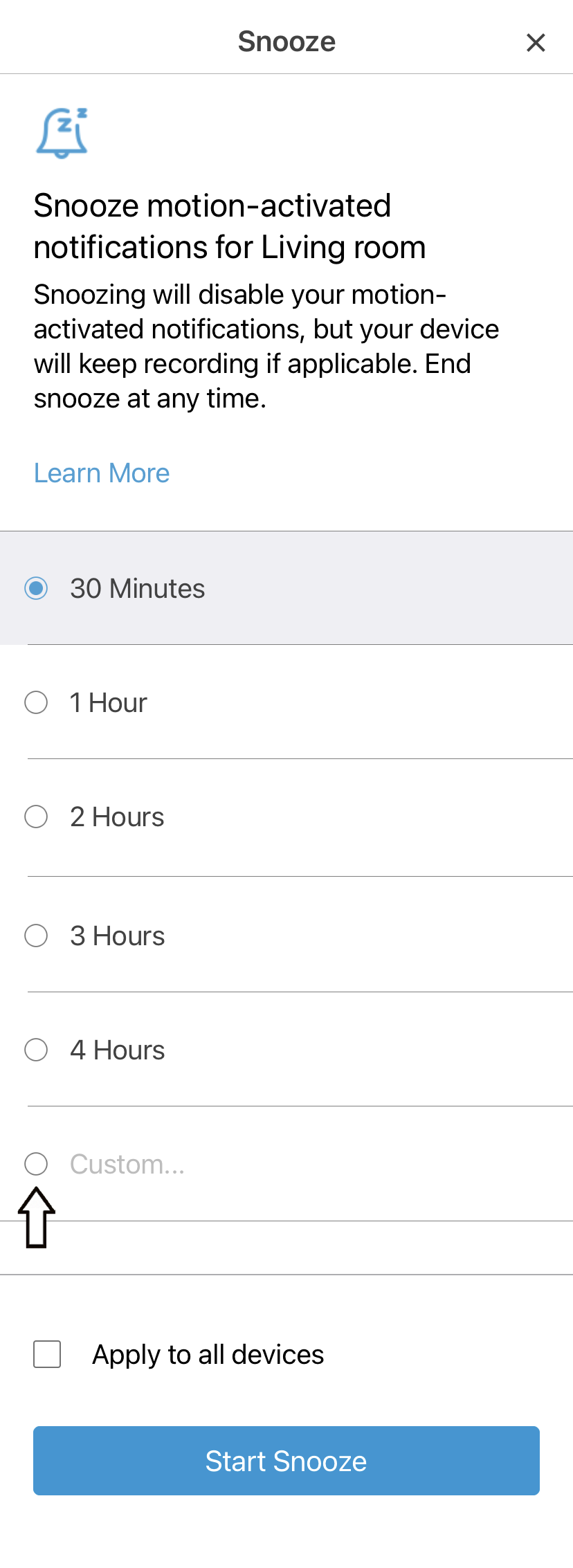
2. Select the amount of time to Snooze your notifications and then tap Start Snooze. You have the flexibility to select any time between 1 minute and 24 hours to stop your notifications.
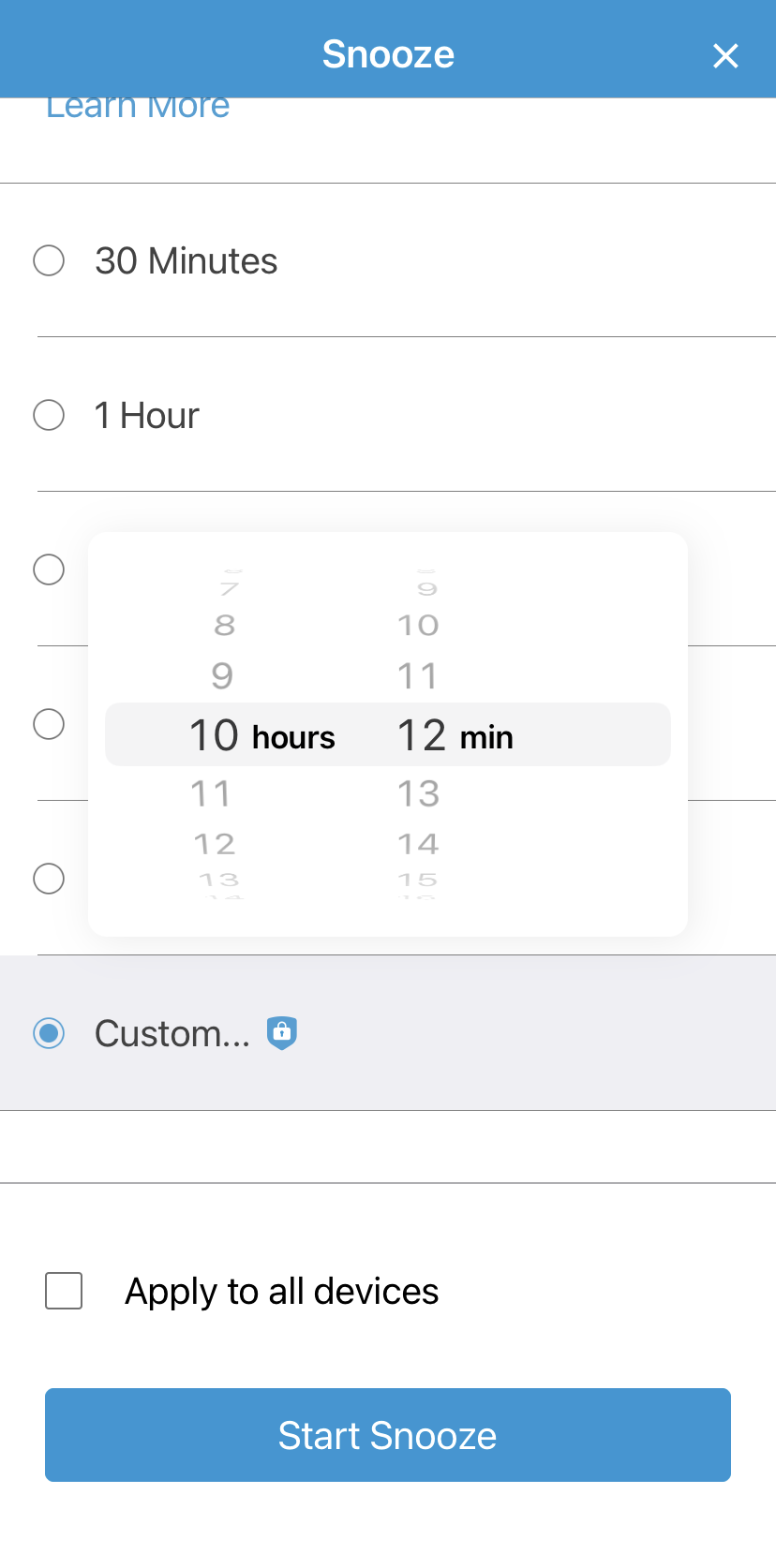
Your set custom Snooze time will then appear as a notification on the Home screen.

